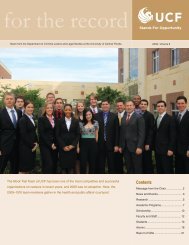Police Technology: An analysis of in-car cameras and body worn ...
Police Technology: An analysis of in-car cameras and body worn ...
Police Technology: An analysis of in-car cameras and body worn ...
Create successful ePaper yourself
Turn your PDF publications into a flip-book with our unique Google optimized e-Paper software.
2011<br />
<strong>Police</strong> <strong>Technology</strong>: <strong>An</strong> <strong>analysis</strong> <strong>of</strong><br />
<strong>in</strong>-<strong>car</strong> <strong>cameras</strong> <strong>and</strong> <strong>body</strong> <strong>worn</strong><br />
<strong>cameras</strong><br />
Lilian Drais<strong>in</strong><br />
University <strong>of</strong> Central Florida, Public<br />
Adm<strong>in</strong>istration Department, PAD 6062<br />
4/1/2011
<strong>Police</strong> <strong>Technology</strong>: <strong>An</strong> <strong>analysis</strong> <strong>of</strong> <strong>in</strong>-<strong>car</strong> <strong>cameras</strong> <strong>and</strong><br />
<strong>body</strong> <strong>worn</strong> <strong>cameras</strong><br />
2011<br />
Table <strong>of</strong> Contents<br />
Executive Summary ........................................................................................................ 3<br />
Summary <strong>of</strong> Recommendations ...................................................................................... 5<br />
History <strong>of</strong> Camera Use .................................................................................................... 6<br />
Introduction ..................................................................................................................... 8<br />
Statement <strong>of</strong> the Problem ............................................................................................ 9<br />
Review <strong>of</strong> Literature ...................................................................................................... 11<br />
Why use <strong>cameras</strong> at all? ............................................................................................ 11<br />
Best Practices ............................................................................................................... 15<br />
What are other agencies do<strong>in</strong>g? ................................................................................ 15<br />
Comparison <strong>An</strong>alysis & Issues ...................................................................................... 22<br />
What are the implementation issues? ..................................................................... 22<br />
Legal Issues ............................................................................................................... 22<br />
Equipment Type <strong>and</strong> Cost <strong>An</strong>alysis ........................................................................... 23<br />
F<strong>in</strong>d<strong>in</strong>gs <strong>and</strong> Recommendations ................................................................................... 28<br />
Conclusion .................................................................................................................... 36<br />
References .................................................................................................................... 37<br />
2 | P age
<strong>Police</strong> <strong>Technology</strong>: <strong>An</strong> <strong>analysis</strong> <strong>of</strong> <strong>in</strong>-<strong>car</strong> <strong>cameras</strong> <strong>and</strong><br />
<strong>body</strong> <strong>worn</strong> <strong>cameras</strong><br />
Executive Summary<br />
2011<br />
At the request <strong>of</strong> the Chief <strong>of</strong> <strong>Police</strong> for the Orl<strong>and</strong>o <strong>Police</strong> Department (OPD) a study<br />
was conducted on the use <strong>of</strong> <strong>in</strong>-<strong>car</strong> <strong>cameras</strong> <strong>and</strong> <strong>body</strong> <strong>worn</strong> <strong>cameras</strong> for law<br />
enforcement use. The purpose <strong>of</strong> this study was to determ<strong>in</strong>e if the Orl<strong>and</strong>o <strong>Police</strong><br />
Department should <strong>in</strong>vest <strong>in</strong> camera systems for <strong>of</strong>ficers, either <strong>in</strong>-<strong>car</strong> <strong>cameras</strong> or <strong>body</strong><br />
<strong>worn</strong> <strong>cameras</strong>; <strong>and</strong> if so, which camera system is most suitable for the agency. The<br />
study focused on the history <strong>of</strong> camera use, what other agencies are do<strong>in</strong>g, current<br />
literature, <strong>and</strong> analyzed camera equipment <strong>and</strong> cost. The follow<strong>in</strong>g research questions<br />
were answered by the study: 1) Why use <strong>cameras</strong> at all? 2) What are other agencies<br />
do<strong>in</strong>g? 3) What are the implementation issues? 4) Which camera type(s) is most useful<br />
for OPD’s needs?<br />
The study described the challenges that the agency is fac<strong>in</strong>g that could be abated by<br />
camera use; driv<strong>in</strong>g under the <strong>in</strong>fluence (DUI) <strong>and</strong> violence aga<strong>in</strong>st <strong>of</strong>ficers. It also<br />
looked at literature that described issues <strong>of</strong> <strong>of</strong>ficer safety, pr<strong>of</strong>essionalism, <strong>and</strong> tra<strong>in</strong><strong>in</strong>g<br />
as they relate to the use <strong>of</strong> camera technology. A review <strong>of</strong> other agencies determ<strong>in</strong>ed<br />
that while many agencies nationwide, statewide, <strong>and</strong> locally use <strong>in</strong>-<strong>car</strong> <strong>cameras</strong>, very<br />
few have implemented the new <strong>body</strong> <strong>worn</strong> <strong>cameras</strong>. Legal issues such as rights <strong>of</strong><br />
privacy are explored <strong>and</strong> determ<strong>in</strong>ed to be a non-issue, <strong>in</strong> accordance with state law.<br />
However, no known case law regard<strong>in</strong>g the <strong>body</strong> <strong>worn</strong> <strong>cameras</strong> was found. Several<br />
different types <strong>of</strong> <strong>body</strong> <strong>worn</strong> <strong>cameras</strong> were analyzed <strong>and</strong> compared to the <strong>in</strong>-<strong>car</strong><br />
<strong>cameras</strong>.<br />
3 | P age
<strong>Police</strong> <strong>Technology</strong>: <strong>An</strong> <strong>analysis</strong> <strong>of</strong> <strong>in</strong>-<strong>car</strong> <strong>cameras</strong> <strong>and</strong><br />
<strong>body</strong> <strong>worn</strong> <strong>cameras</strong><br />
The result <strong>of</strong> the study concluded with the recommendation that the Orl<strong>and</strong>o <strong>Police</strong><br />
2011<br />
Department proceed with the implementation <strong>of</strong> <strong>cameras</strong> for <strong>of</strong>ficers. However, due to<br />
several factors, such as; cost, legality issues with <strong>body</strong> <strong>cameras</strong>, lack <strong>of</strong> evaluation <strong>of</strong><br />
new technology, <strong>and</strong> <strong>of</strong>ficer acceptance, the most effective <strong>and</strong> efficient approach is a<br />
mixed-technology <strong>and</strong> multi-phase approach; us<strong>in</strong>g both types <strong>of</strong> camera systems for<br />
different purposes. This approach would implement a camera technology project <strong>in</strong><br />
multiple phases, allow<strong>in</strong>g for further equipment test<strong>in</strong>g, evaluation, <strong>and</strong> leverag<strong>in</strong>g <strong>of</strong><br />
fund<strong>in</strong>g sources. It is also recommended that the agency publish a policy directly related<br />
to <strong>in</strong>-<strong>car</strong> <strong>and</strong> <strong>body</strong> <strong>worn</strong> <strong>cameras</strong>. Proper tra<strong>in</strong><strong>in</strong>g on this policy <strong>and</strong> on the equipment is<br />
also recommended, as well as ensur<strong>in</strong>g that a thorough logistics plan is <strong>in</strong> place prior to<br />
implementation. All <strong>of</strong> these recommendations will ensure the agency proceeds with a<br />
project that is effective, efficient, <strong>and</strong> ma<strong>in</strong>ta<strong>in</strong>s the agency’s <strong>and</strong> <strong>of</strong>ficer’s <strong>in</strong>tegrity.<br />
4 | P age
<strong>Police</strong> <strong>Technology</strong>: <strong>An</strong> <strong>analysis</strong> <strong>of</strong> <strong>in</strong>-<strong>car</strong> <strong>cameras</strong> <strong>and</strong><br />
<strong>body</strong> <strong>worn</strong> <strong>cameras</strong><br />
Summary <strong>of</strong> Recommendations<br />
2011<br />
Recommendation 1: The Orl<strong>and</strong>o <strong>Police</strong> Department (OPD) should implement the use<br />
<strong>of</strong> camera technology through a mixed technology <strong>and</strong> multi-year (phased) approach.<br />
Recommendation 2: In-Car <strong>cameras</strong> should be st<strong>and</strong>ard equipment for all marked<br />
patrol vehicles <strong>and</strong> all unmarked vehicles whose primary duties <strong>in</strong>clude traffic<br />
enforcement or drug enforcement.<br />
Recommendation 3: Body <strong>worn</strong> <strong>cameras</strong> should be st<strong>and</strong>ard equipment for all <strong>of</strong>ficers<br />
<strong>in</strong> units that have high <strong>in</strong>stances <strong>of</strong> citizen contact <strong>and</strong> self-<strong>in</strong>itiated calls.<br />
Recommendation 4: OPD should purchase the lapel style <strong>body</strong> <strong>worn</strong> <strong>cameras</strong>.<br />
Recommendation 5: OPD should only purchase camera technology that <strong>in</strong>cludes<br />
s<strong>of</strong>tware from the vendor that can be managed by OPD.<br />
Recommendation 6: OPD should develop policies <strong>and</strong> procedures for camera<br />
technology <strong>and</strong> ensure these policies <strong>and</strong> procedures are <strong>in</strong> place, prior to camera use.<br />
Recommendation 7: OPD should ensure that all personnel are properly tra<strong>in</strong>ed on the<br />
use <strong>of</strong> the <strong>cameras</strong> as well as the policies <strong>and</strong> procedures address<strong>in</strong>g camera use.<br />
Recommendation 8: OPD should develop a logistics plan prior to project<br />
implementation.<br />
Recommendation 9: OPD should evaluate each phase <strong>of</strong> the implementation plan <strong>in</strong><br />
order to ensure the projects efficiency <strong>and</strong> effectiveness.<br />
5 | P age
<strong>Police</strong> <strong>Technology</strong>: <strong>An</strong> <strong>analysis</strong> <strong>of</strong> <strong>in</strong>-<strong>car</strong> <strong>cameras</strong> <strong>and</strong><br />
<strong>body</strong> <strong>worn</strong> <strong>cameras</strong><br />
History <strong>of</strong> Camera Use<br />
The <strong>in</strong>itiative to outfit police vehicles with <strong>cameras</strong> began <strong>in</strong> 1980, when Mothers<br />
Aga<strong>in</strong>st Drunk Drivers (MADD) was formed. MADD brought great awareness to the<br />
2011<br />
problem <strong>of</strong> driv<strong>in</strong>g under the <strong>in</strong>fluence (DUI) <strong>and</strong> police departments began <strong>in</strong>stall<strong>in</strong>g<br />
<strong>cameras</strong> <strong>in</strong> vehicles to document DUI stops <strong>and</strong> arrests. The video from DUI stops<br />
provides the necessary evidence for the conviction <strong>of</strong> drunk drivers. From there, the <strong>in</strong>-<br />
<strong>car</strong> <strong>cameras</strong> were used <strong>in</strong> the 1990’s not only for DUI’s, but for drug arrests. It was<br />
dur<strong>in</strong>g this time that America’s “war on drugs” began (International Association <strong>of</strong> Chiefs<br />
<strong>of</strong> <strong>Police</strong> [IACP], 2004, p 5). In-<strong>car</strong> <strong>cameras</strong> were able to provide juries with video<br />
evidence <strong>of</strong> traffic stops, consent to search, <strong>and</strong> the drug evidence found dur<strong>in</strong>g the<br />
stop; conviction rates soared (IACP, 2004, p.5).<br />
In the late 1990’s racial bias/ racial pr<strong>of</strong>il<strong>in</strong>g was the major issue fac<strong>in</strong>g police. <strong>Police</strong><br />
<strong>of</strong>ficers across the country found themselves be<strong>in</strong>g <strong>in</strong>vestigated for racial pr<strong>of</strong>il<strong>in</strong>g<br />
(IACP, 2004, p.5). <strong>Police</strong> agencies throughout the United States were <strong>in</strong>undated with<br />
lawsuits “alleg<strong>in</strong>g race-based traffic stops” (IACP, 2004, p.5). In some cases, the courts<br />
determ<strong>in</strong>ed that racial pr<strong>of</strong>il<strong>in</strong>g did occur <strong>and</strong> this enhanced the public’s perception <strong>of</strong><br />
racial pr<strong>of</strong>il<strong>in</strong>g by police. Public confidence <strong>in</strong> law enforcement decl<strong>in</strong>ed (Westphal,<br />
2004). Also dur<strong>in</strong>g this same time, <strong>in</strong>cidents <strong>of</strong> violence aga<strong>in</strong>st the police rose<br />
dramatically (IACP, 2004, p.5). Due to the issue <strong>of</strong> racial pr<strong>of</strong>il<strong>in</strong>g, the Federal<br />
government began to require that all traffic stops be documented. In-<strong>car</strong> <strong>cameras</strong><br />
became even more common amongst law enforcement agencies as a means to<br />
document stops <strong>and</strong> dispute claims <strong>of</strong> racial pr<strong>of</strong>il<strong>in</strong>g (IACP, 2004, p.5).<br />
6 | P age
<strong>Police</strong> <strong>Technology</strong>: <strong>An</strong> <strong>analysis</strong> <strong>of</strong> <strong>in</strong>-<strong>car</strong> <strong>cameras</strong> <strong>and</strong><br />
<strong>body</strong> <strong>worn</strong> <strong>cameras</strong><br />
Still today, <strong>in</strong>-<strong>car</strong> <strong>cameras</strong> are most prom<strong>in</strong>ent <strong>in</strong> state agencies; state police <strong>and</strong><br />
2011<br />
highway patrol. These agencies mostly work traffic related <strong>in</strong>cidents. As <strong>of</strong> 2004, it was<br />
estimated that 72% <strong>of</strong> all state police <strong>and</strong> highway patrol vehicles were equipped with<br />
<strong>in</strong>-<strong>car</strong> camera systems. As <strong>of</strong> 2004, there were over 17,500 <strong>cameras</strong> <strong>in</strong> state police<br />
vehicles nationwide. Advances <strong>in</strong> technology <strong>and</strong> grant programs cont<strong>in</strong>ue to <strong>in</strong>crease<br />
the use <strong>of</strong> <strong>in</strong>-<strong>car</strong> camera use <strong>in</strong> state agencies as well as local law enforcement<br />
agencies (IACP, 2004, p. 6). More recently, new technology has been <strong>in</strong>troduced that<br />
allows <strong>of</strong>ficers to wear <strong>cameras</strong> on their person, enhanc<strong>in</strong>g the potential capabilities <strong>of</strong><br />
camera use.<br />
7 | P age
<strong>Police</strong> <strong>Technology</strong>: <strong>An</strong> <strong>analysis</strong> <strong>of</strong> <strong>in</strong>-<strong>car</strong> <strong>cameras</strong> <strong>and</strong><br />
<strong>body</strong> <strong>worn</strong> <strong>cameras</strong><br />
Introduction<br />
2011<br />
The City <strong>of</strong> Orl<strong>and</strong>o currently has 228,765 residents (Florida League <strong>of</strong> Cities, 2011).<br />
The Orl<strong>and</strong>o <strong>Police</strong> Department currently has an authorized strength <strong>of</strong> 743 s<strong>worn</strong><br />
personnel. This <strong>in</strong>cludes 622 <strong>of</strong>ficers, 78 sergeants, 29 lieutenants, 9 capta<strong>in</strong>s, 4 deputy<br />
chiefs <strong>and</strong> 1 chief <strong>of</strong> police (Orl<strong>and</strong>o <strong>Police</strong> Department, 2010). The traffic units <strong>and</strong> first<br />
responders are most likely to use camera systems; units that respond to calls for<br />
service, conduct self-<strong>in</strong>itiated citizen contacts, <strong>and</strong> traffic related calls. These units or<br />
sections <strong>in</strong>clude the Traffic Enforcement Section, The Uniform Drug Enforcement<br />
Section, the Patrol Services Bureau, the K-9 Unit <strong>and</strong> the Community Polic<strong>in</strong>g Section,<br />
Downtown Bikes <strong>and</strong> Parramore Heritage Bikes. The Traffic Enforcement Section has a<br />
staff<strong>in</strong>g <strong>of</strong> 20 <strong>of</strong>ficers <strong>and</strong> 3 supervisors. The Uniform Drug Enforcement Section has 16<br />
<strong>of</strong>ficers <strong>and</strong> 2 supervisors. The Patrol Services Bureau has 399 s<strong>worn</strong> personnel<br />
assigned. The K-9 Unit has 11 <strong>of</strong>ficers <strong>and</strong> 2 supervisors, <strong>and</strong> the Community Polic<strong>in</strong>g<br />
Section, Downtown Bikes <strong>and</strong> Parramore Heritage Bikes, has 35 <strong>of</strong>ficers <strong>and</strong> 4<br />
supervisors. This is a total <strong>of</strong> 492 members that are most likely to benefit from the use<br />
<strong>of</strong> <strong>cameras</strong>, either <strong>in</strong>-<strong>car</strong> <strong>cameras</strong> or <strong>body</strong> <strong>worn</strong> <strong>cameras</strong> (Orl<strong>and</strong>o <strong>Police</strong> Department,<br />
2010).<br />
The purpose <strong>of</strong> this study is to determ<strong>in</strong>e if the Orl<strong>and</strong>o <strong>Police</strong> Department should <strong>in</strong>vest<br />
<strong>in</strong> camera systems for <strong>of</strong>ficers, either <strong>in</strong>-<strong>car</strong> <strong>cameras</strong> or <strong>body</strong> <strong>worn</strong> <strong>cameras</strong>; <strong>and</strong> if so,<br />
which camera system is most suitable for the agency. This research study focuses on<br />
the history <strong>of</strong> camera use, an <strong>analysis</strong> <strong>of</strong> what other compatible agencies are do<strong>in</strong>g,<br />
8 | P age
<strong>Police</strong> <strong>Technology</strong>: <strong>An</strong> <strong>analysis</strong> <strong>of</strong> <strong>in</strong>-<strong>car</strong> <strong>cameras</strong> <strong>and</strong><br />
<strong>body</strong> <strong>worn</strong> <strong>cameras</strong><br />
2011<br />
current literature, a review <strong>of</strong> the camera equipment, <strong>and</strong> provides a recommendation<br />
on camera use for the agency. This study will answer the follow<strong>in</strong>g research questions:<br />
1) Why use <strong>cameras</strong> at all? 2) What are other agencies do<strong>in</strong>g? 3) What are the<br />
implementation issues? 4) Which camera type(s) is most useful for OPD’s needs?<br />
Statement <strong>of</strong> the Problem<br />
The City <strong>of</strong> Orl<strong>and</strong>o has been faced with a ris<strong>in</strong>g DUI problem. As compared to other<br />
large cities <strong>in</strong> Florida, Orl<strong>and</strong>o was ranked number one for DUI related deaths. From<br />
2007 to 2010, there were 55 traffic fatalities <strong>and</strong> more than 2,300 DUI traffic citations<br />
issued (Orl<strong>and</strong>o <strong>Police</strong> Department, 2011). The Orl<strong>and</strong>o <strong>Police</strong> Department realizes the<br />
seriousness <strong>of</strong> this problem <strong>and</strong> has implemented countermeasures to combat the<br />
problem. The agency has a small group <strong>of</strong> <strong>of</strong>ficers (6), on patrol, that drive aggressive<br />
driv<strong>in</strong>g vehicles. These vehicles were provided to the agency through a grant. In<br />
addition, the agency is currently develop<strong>in</strong>g a DUI Enforcement Team. This team <strong>of</strong> 8<br />
<strong>of</strong>ficers <strong>and</strong> 1 supervisor will focus on DUI’s <strong>and</strong> other traffic violations. OPD is<br />
consider<strong>in</strong>g <strong>in</strong>-<strong>car</strong> <strong>cameras</strong> for these vehicles (Orl<strong>and</strong>o <strong>Police</strong> Department, 2011 April).<br />
Currently, the Orl<strong>and</strong>o <strong>Police</strong> Department has <strong>in</strong>-<strong>car</strong> <strong>cameras</strong> <strong>in</strong>stalled <strong>in</strong> 4 unmarked<br />
patrol vehicles, 2 marked patrol vehicles <strong>and</strong> 11 Drug Enforcement Division (DED)<br />
vehicles. The patrol vehicles equipped with <strong>in</strong>-<strong>car</strong> <strong>cameras</strong> are <strong>in</strong>stalled <strong>in</strong> vehicles that<br />
look for aggressive drivers <strong>and</strong> drivers that may be under the <strong>in</strong>fluence (Officer B.<br />
Cechowski, personal communication, April 5, 2011). The DED <strong>in</strong>-<strong>car</strong> <strong>cameras</strong> are used<br />
to record drug stops (Detective L. R<strong>and</strong>olph, personal communication, February 3,<br />
9 | P age
<strong>Police</strong> <strong>Technology</strong>: <strong>An</strong> <strong>analysis</strong> <strong>of</strong> <strong>in</strong>-<strong>car</strong> <strong>cameras</strong> <strong>and</strong><br />
<strong>body</strong> <strong>worn</strong> <strong>cameras</strong><br />
2011). These <strong>cameras</strong> were funded through a grant project (Officer B. Cechowski,<br />
2011<br />
personal communication, April 5, 2011). The agency is currently test<strong>in</strong>g 6 <strong>body</strong> <strong>worn</strong><br />
<strong>cameras</strong> from 2 different vendors. Currently, no other <strong>of</strong>ficers, except the test subjects,<br />
are assigned <strong>body</strong> <strong>worn</strong> <strong>cameras</strong> (Detective L. R<strong>and</strong>olph, personal communication,<br />
February 3, 2011).<br />
The Orl<strong>and</strong>o <strong>Police</strong> Department is faced with another challenge. Although <strong>in</strong> the past<br />
few years a majority <strong>of</strong> violent crime <strong>in</strong> the City has been on the decl<strong>in</strong>e, violence<br />
aga<strong>in</strong>st <strong>of</strong>ficers cont<strong>in</strong>ues to be a problem. Between 2007 <strong>and</strong> 2010, OPD <strong>of</strong>ficers had<br />
to use force 2,434 times (Sergeant T. Woodhall, personal communication, April 8,<br />
2011); OPD <strong>of</strong>ficers used deadly force 21 times (Orl<strong>and</strong>o <strong>Police</strong> Department, December<br />
2010). The use <strong>of</strong> force may <strong>in</strong>volve the use <strong>of</strong> the Taser, take downs, strikes, impact<br />
weapons, chemical agents, K-9’s, <strong>and</strong> stop sticks. In 2010 alone, 135 <strong>of</strong>ficers were<br />
battered, with 60 report<strong>in</strong>g <strong>in</strong>jury (Sergeant T. Woodhall, personal communication, April<br />
8, 2011).<br />
10 | P age
<strong>Police</strong> <strong>Technology</strong>: <strong>An</strong> <strong>analysis</strong> <strong>of</strong> <strong>in</strong>-<strong>car</strong> <strong>cameras</strong> <strong>and</strong><br />
<strong>body</strong> <strong>worn</strong> <strong>cameras</strong><br />
Review <strong>of</strong> Literature<br />
Why use <strong>cameras</strong> at all?<br />
In 2002, the Community Oriented Polic<strong>in</strong>g Services (COPS) Office worked with the<br />
2011<br />
International Association <strong>of</strong> Chiefs <strong>of</strong> <strong>Police</strong> (IACP) to complete an 18 month evaluation<br />
on the use <strong>of</strong> <strong>in</strong>-<strong>car</strong> video <strong>cameras</strong> by state agencies that the COPS Office provided<br />
fund<strong>in</strong>g to. This was a two part study focus<strong>in</strong>g on process <strong>and</strong> impact (IACP, 2004, p.1).<br />
The impact <strong>of</strong> the “value <strong>of</strong> <strong>cameras</strong> on the agencies” is most relevant (IACP, 2004,<br />
p.2). The impact evaluation determ<strong>in</strong>ed that the use <strong>of</strong> the <strong>in</strong>-<strong>car</strong> <strong>cameras</strong> had a<br />
dramatic positive impact on the agencies. The researchers conducted surveys, worked<br />
with research groups, <strong>and</strong> completed <strong>in</strong>terviews <strong>of</strong> 21 state agencies, <strong>in</strong>clud<strong>in</strong>g the<br />
Florida Highway Patrol (IACP, 2004, p.1). This process measured the impact <strong>of</strong> <strong>in</strong>-<strong>car</strong><br />
<strong>cameras</strong> on issues such as: <strong>of</strong>ficer safety, <strong>of</strong>ficer pr<strong>of</strong>essionalism/perception, liability,<br />
tra<strong>in</strong><strong>in</strong>g, policy, leadership <strong>and</strong> the judicial process (IACP, 2004, p.2). Most agencies<br />
provide three <strong>of</strong> these issues as reasons why they have implemented camera<br />
programs: <strong>of</strong>ficer safety, pr<strong>of</strong>essionalism/perception, <strong>and</strong> tra<strong>in</strong><strong>in</strong>g.<br />
Officer Safety: The COPS Office study discussed a major problem for law enforcement,<br />
<strong>of</strong>ficer safety. Officers are frequently be<strong>in</strong>g assaulted <strong>and</strong> <strong>in</strong>volved <strong>in</strong> traffic accidents<br />
while on duty (IACP, 2004. P.13). Even worse, the <strong>in</strong>stances <strong>of</strong> <strong>of</strong>ficer on-duty deaths<br />
have risen dramatically <strong>in</strong> recent years. Last year, on-duty deaths rose by 26%<br />
nationwide; 49 <strong>of</strong>ficers were shot to death <strong>in</strong> 2009 <strong>and</strong> 61 <strong>in</strong> 2010. Thus far this year,<br />
the death rate statistics are even more devastat<strong>in</strong>g. With<strong>in</strong> one 24-hour time period <strong>in</strong><br />
January, 11 <strong>of</strong>ficers were shot nationwide. Eleven more <strong>of</strong>ficers were killed by gunfire <strong>in</strong><br />
11 | P age
<strong>Police</strong> <strong>Technology</strong>: <strong>An</strong> <strong>analysis</strong> <strong>of</strong> <strong>in</strong>-<strong>car</strong> <strong>cameras</strong> <strong>and</strong><br />
<strong>body</strong> <strong>worn</strong> <strong>cameras</strong><br />
2011<br />
February 2011, “doubl<strong>in</strong>g the national trend <strong>of</strong> each <strong>of</strong> the previous years <strong>of</strong> the last<br />
decade” (Fredricks, 2011). In 2010, Florida saw n<strong>in</strong>e <strong>of</strong>ficers killed <strong>in</strong> the l<strong>in</strong>e <strong>of</strong> duty.<br />
Four <strong>of</strong> these deaths were from automobile accidents, one <strong>of</strong>ficer was struck by a<br />
vehicle, <strong>and</strong> four were shot to death. Just this year alone, (January –April 2011) 55<br />
<strong>of</strong>ficers have died nationwide, 10 <strong>of</strong>ficers died <strong>in</strong> the l<strong>in</strong>e <strong>of</strong> duty <strong>in</strong> Florida. Six <strong>of</strong> these<br />
<strong>of</strong>ficers were shot to death, while one died from an automobile accident, <strong>and</strong> three died<br />
from natural work-related causes (heart attack <strong>and</strong> bacterial <strong>in</strong>fection) (Officer Down<br />
Memorial Page, 2011). After the tragic death <strong>of</strong> Orange County Deputy, Br<strong>and</strong>on<br />
Coates, a local news channel said, “<strong>cameras</strong> may have provided objective <strong>in</strong>sight <strong>in</strong>to<br />
the roadside shoot<strong>in</strong>g that killed Deputy Br<strong>and</strong>on Coates” (WESH, 2011). <strong>An</strong>other local<br />
tragedy occurred <strong>in</strong> Tampa <strong>in</strong> June <strong>of</strong> 2010 that shows the value <strong>of</strong> camera use.<br />
Officers Curtis <strong>and</strong> Kocab were murdered while they were conduct<strong>in</strong>g a traffic stop.<br />
Officer Curtis’ video system recorded the tragic event. The system recorded video <strong>and</strong><br />
audio <strong>of</strong> the suspects <strong>and</strong> provided identification <strong>in</strong>formation received dur<strong>in</strong>g the stop.<br />
This video assisted <strong>in</strong> the capture <strong>of</strong> the suspects (Fredricks, 2011).<br />
Pr<strong>of</strong>essionalism/ Public Perception: Proponents <strong>and</strong> vendors <strong>of</strong> the <strong>body</strong> <strong>worn</strong> <strong>cameras</strong><br />
propose that the use <strong>of</strong> video would “improve police accountability, reduce compla<strong>in</strong>ts <strong>of</strong><br />
police misconduct, <strong>and</strong> save the city hundreds <strong>of</strong> thous<strong>and</strong>s <strong>of</strong> dollars <strong>in</strong> court costs”<br />
(Howl<strong>and</strong>, 2011). The vendors argue that the <strong>body</strong> <strong>worn</strong> <strong>cameras</strong> would reduce the<br />
number <strong>of</strong> compla<strong>in</strong>ts aga<strong>in</strong>st <strong>of</strong>ficers for misconduct, <strong>and</strong> it would save the city money<br />
related to court costs <strong>and</strong> overtime costs for <strong>of</strong>ficers who have to appear <strong>in</strong> court for<br />
these cases (Howl<strong>and</strong>, 2011). Out <strong>of</strong> the prosecutors who were surveyed <strong>in</strong> the COPS<br />
12 | P age
<strong>Police</strong> <strong>Technology</strong>: <strong>An</strong> <strong>analysis</strong> <strong>of</strong> <strong>in</strong>-<strong>car</strong> <strong>cameras</strong> <strong>and</strong><br />
<strong>body</strong> <strong>worn</strong> <strong>cameras</strong><br />
2011<br />
study, 91% <strong>of</strong> them stated that they used the video record<strong>in</strong>g <strong>in</strong> court. They also stated<br />
hav<strong>in</strong>g the video dramatically reduced court time <strong>and</strong> expenses (IACP, 2004. p.22).<br />
The COPS study also found that the <strong>cameras</strong> improved the <strong>of</strong>ficer’s ability to respond to<br />
compla<strong>in</strong>ts regard<strong>in</strong>g their pr<strong>of</strong>essionalism. The <strong>cameras</strong> also cleared <strong>of</strong>ficers <strong>of</strong> any<br />
wrong do<strong>in</strong>g <strong>in</strong> <strong>in</strong>ternal <strong>in</strong>vestigations. With<strong>in</strong> the agencies studied, only 5% <strong>of</strong> compla<strong>in</strong>t<br />
cases were susta<strong>in</strong>ed, due to the recorded evidence (IACP, 2004. p.22). Video<br />
evidence reduced the number <strong>of</strong> compla<strong>in</strong>ts <strong>and</strong> reduced the amount <strong>of</strong> time spent on<br />
<strong>in</strong>ternal <strong>in</strong>vestigations. The <strong>in</strong>ternal affairs sections realized that the majority <strong>of</strong> the<br />
compla<strong>in</strong>ts were h<strong>and</strong>led at the supervisory level, which lead to the reduction (IACP,<br />
2004. p.22).<br />
In 2010, a Duluth, M<strong>in</strong>nesota <strong>of</strong>ficer was cleared <strong>of</strong> wrongdo<strong>in</strong>g after he shot a 17 year<br />
old. His video showed the suspect hitt<strong>in</strong>g <strong>and</strong> smash<strong>in</strong>g the <strong>of</strong>ficer’s driver’s side patrol<br />
<strong>car</strong> w<strong>in</strong>dow with a baseball bat while the <strong>of</strong>ficer was <strong>in</strong> the vehicle. The video also<br />
showed the teen fail<strong>in</strong>g to respond to the comm<strong>and</strong>s <strong>of</strong> the <strong>of</strong>ficer to put down the<br />
weapon (bat). This case is one that aga<strong>in</strong> depicts the value <strong>of</strong> video, protect<strong>in</strong>g <strong>of</strong>ficers<br />
from false claims <strong>of</strong> misconduct (Orl<strong>and</strong>o Sent<strong>in</strong>el, 2011).<br />
The COPS evaluation concluded that the number one reason for <strong>cameras</strong> is to “collect<br />
evidence for trial; to protect <strong>of</strong>ficer from false accusation” (IACP, 2004, p.16). However,<br />
the second purpose for camera usage, as determ<strong>in</strong>ed by these <strong>of</strong>ficers was to monitor<br />
their performance (IACP, 2004, p.16). Community perspective is also an area looked at<br />
13 | P age
<strong>Police</strong> <strong>Technology</strong>: <strong>An</strong> <strong>analysis</strong> <strong>of</strong> <strong>in</strong>-<strong>car</strong> <strong>cameras</strong> <strong>and</strong><br />
<strong>body</strong> <strong>worn</strong> <strong>cameras</strong><br />
2011<br />
through this evaluation. Public forums were held <strong>in</strong> 12 states, <strong>in</strong> addition, 900 citizens<br />
from 18 states responded to surveys. The result was that 94% <strong>of</strong> citizens supported the<br />
use <strong>of</strong> <strong>in</strong>-<strong>car</strong> <strong>cameras</strong> <strong>and</strong> 71% said they thought the public should be <strong>in</strong>formed when<br />
they are be<strong>in</strong>g videotaped (IACP, 2004, p.16). In addition, 51% said that they would<br />
change their behavior if they were be<strong>in</strong>g videotaped (IACP, 2004, p.16). Overall, the<br />
IACP evaluation determ<strong>in</strong>ed that the <strong>in</strong>-<strong>car</strong> camera programs had a “tremendous impact<br />
on advanc<strong>in</strong>g technology for the state police <strong>and</strong> highway patrol agencies” (IACP, 2004,<br />
p.28).<br />
Tra<strong>in</strong><strong>in</strong>g: The <strong>of</strong>ficer survey results from the COPS evaluation showed that only one-<br />
third <strong>of</strong> the <strong>of</strong>ficers actually felt an <strong>in</strong>crease <strong>in</strong> safety with the use <strong>of</strong> the <strong>cameras</strong>.<br />
However, a large majority <strong>of</strong> <strong>of</strong>ficers said <strong>in</strong> the <strong>in</strong>terviews that they use the <strong>cameras</strong> as<br />
a tra<strong>in</strong><strong>in</strong>g tool <strong>and</strong> to self-critique. The <strong>of</strong>ficers also said that they believed the use <strong>of</strong><br />
<strong>cameras</strong> deescalated confrontational situations, promot<strong>in</strong>g safety. In addition, the more<br />
tra<strong>in</strong><strong>in</strong>g the <strong>of</strong>ficers received on the system, the more they believed the <strong>cameras</strong><br />
improved safety; 77% <strong>of</strong> the <strong>of</strong>ficers <strong>in</strong>terviewed said they never received tra<strong>in</strong><strong>in</strong>g on<br />
how to use the <strong>cameras</strong>. Less than half <strong>of</strong> the <strong>of</strong>ficers said they received tra<strong>in</strong><strong>in</strong>g on<br />
laws or departmental policies regard<strong>in</strong>g camera use (IACP, 2004, p.18).<br />
14 | P age
<strong>Police</strong> <strong>Technology</strong>: <strong>An</strong> <strong>analysis</strong> <strong>of</strong> <strong>in</strong>-<strong>car</strong> <strong>cameras</strong> <strong>and</strong><br />
<strong>body</strong> <strong>worn</strong> <strong>cameras</strong><br />
Best Practices<br />
What are other agencies do<strong>in</strong>g?<br />
This study compares four other Florida agencies to the Orl<strong>and</strong>o <strong>Police</strong> Department.<br />
2011<br />
These four agencies are: Tampa <strong>Police</strong> Department, St. Petersburg <strong>Police</strong> Department,<br />
Hialeah <strong>Police</strong> Department, <strong>and</strong> Ft. Lauderdale <strong>Police</strong> Department. These agencies<br />
were chosen because they are all Florida municipal law enforcement agencies, they are<br />
the similar <strong>in</strong> size <strong>in</strong>, <strong>and</strong> the city populations are similar (Florida League <strong>of</strong> Cities,<br />
2011). Each agency was contacted <strong>and</strong> asked if they used <strong>in</strong>-<strong>car</strong> <strong>cameras</strong> <strong>and</strong>/or <strong>body</strong><br />
<strong>worn</strong> <strong>cameras</strong>; if so, how many <strong>of</strong>ficers or vehicles were assigned camera units. The<br />
agencies were also asked to provide copies <strong>of</strong> any policy they have regard<strong>in</strong>g the use <strong>of</strong><br />
<strong>cameras</strong>. The results are depicted <strong>in</strong> the chart below. None <strong>of</strong> the agencies reported<br />
us<strong>in</strong>g <strong>body</strong> <strong>worn</strong> <strong>cameras</strong>. Tampa, St. Petersburg, <strong>and</strong> Ft. Lauderdale reported us<strong>in</strong>g<br />
<strong>in</strong>-<strong>car</strong> <strong>cameras</strong> for traffic enforcement purposes.<br />
Comparison <strong>An</strong>alysis <strong>of</strong> Florida Municipal L.E. Agencies by Population <strong>and</strong> Agency Size<br />
City City Population<br />
# <strong>of</strong> s<strong>worn</strong><br />
personnel<br />
In-<strong>car</strong> camera,<br />
if yes # <strong>of</strong> units<br />
Body <strong>worn</strong><br />
<strong>cameras</strong>, if yes,<br />
# <strong>of</strong> units<br />
Tampa 336,264* 977² Yes unknown<br />
St. Petersburg 253,369* 540 Yes, 6³ No³<br />
Orl<strong>and</strong>o 228,765* 743º Yes., 22 No<br />
Hialeah 228,528* 347¹ No¹ No¹<br />
Ft. Lauderdale 179,971* 511^ 30^ No^<br />
*Source: Bureau <strong>of</strong> Economic <strong>and</strong> Bus<strong>in</strong>ess Research, University <strong>of</strong> Florida, 2007<br />
¹Hialeah <strong>Police</strong> Department<br />
²Tampa <strong>Police</strong> Department<br />
^Ft. Lauderdale <strong>Police</strong> Department<br />
°Orl<strong>and</strong>o <strong>Police</strong> Department Organizational Chart<br />
³St. Petersburg <strong>Police</strong> Department<br />
15 | P age
<strong>Police</strong> <strong>Technology</strong>: <strong>An</strong> <strong>analysis</strong> <strong>of</strong> <strong>in</strong>-<strong>car</strong> <strong>cameras</strong> <strong>and</strong><br />
<strong>body</strong> <strong>worn</strong> <strong>cameras</strong><br />
2011<br />
Additionally, a Florida <strong>Police</strong> Accreditation Coalition (FLA-PAC) request was sent out to<br />
all Florida agencies request<strong>in</strong>g <strong>in</strong>formation <strong>and</strong> copies <strong>of</strong> video camera policies, either<br />
<strong>in</strong>-<strong>car</strong> or <strong>body</strong> <strong>worn</strong>. The Boca Raton <strong>Police</strong> Department, Ft. Myers <strong>Police</strong> Department,<br />
Brevard County Sheriff’s Office, Manalapan <strong>Police</strong> Department, St. Lucie Sheriff’s<br />
Office, Clearwater <strong>Police</strong> Department <strong>and</strong> Highl<strong>and</strong>s County Sheriff’s Office responded<br />
with copies <strong>of</strong> their agency’s policy on <strong>in</strong>-<strong>car</strong> <strong>cameras</strong>. No agency responded with any<br />
<strong>in</strong>formation on the use <strong>of</strong> <strong>body</strong> <strong>worn</strong> <strong>cameras</strong>. Information was gathered on these<br />
agencies for a general comparison. They were not used for <strong>analysis</strong> because they were<br />
either county agencies <strong>and</strong>/or they did not have a similar population to Orl<strong>and</strong>o. The<br />
data is for <strong>in</strong>formation use only.<br />
Respondents to Florida Agency PAC Request, Informational Data<br />
City/County City Population<br />
# <strong>of</strong> s<strong>worn</strong><br />
personnel<br />
In-<strong>car</strong><br />
<strong>cameras</strong>, if yes<br />
# <strong>of</strong> units<br />
Body <strong>worn</strong><br />
<strong>cameras</strong>, if yes,<br />
# <strong>of</strong> units<br />
Boca Raton 86,445¹ 191 Yes/150 No<br />
Ft. Myers 64,674¹ 173² Yes Unknown<br />
Brevard County 536,357¹ 501* Yes/20 Yes/2<br />
Manalapan 343¹ 10 Yes/4 No<br />
St. Lucie<br />
County<br />
266,502¹ 260² Yes Unknown<br />
Clearwater 106,642¹ 248² Yes Unknown<br />
Highl<strong>and</strong>s<br />
County<br />
98,704¹ 130² Yes Unknown<br />
¹http://www.city-data.com<br />
²FBI http://www2.fbi.gov/ucr/cius2009/data/table_78_fl.html<br />
*Brevard County Sheriff’s Office<br />
As stated, no policies were provided regard<strong>in</strong>g <strong>body</strong> <strong>worn</strong> <strong>cameras</strong>. However, a review<br />
<strong>of</strong> the policies from these <strong>in</strong>formational agencies has revealed that the <strong>in</strong>-<strong>car</strong> camera<br />
policies are very similar across agencies <strong>and</strong> are generally used for DUI <strong>in</strong>vestigations<br />
16 | P age
<strong>Police</strong> <strong>Technology</strong>: <strong>An</strong> <strong>analysis</strong> <strong>of</strong> <strong>in</strong>-<strong>car</strong> <strong>cameras</strong> <strong>and</strong><br />
<strong>body</strong> <strong>worn</strong> <strong>cameras</strong><br />
2011<br />
<strong>and</strong> various other traffic related <strong>in</strong>cidents. The major characteristics <strong>of</strong> these policies<br />
outl<strong>in</strong>e when the <strong>in</strong>-<strong>car</strong> <strong>cameras</strong> can be/or are required to be used, what the video<br />
download requirements are, <strong>and</strong> describe what the limitations are regard<strong>in</strong>g the<br />
recorded data. Most <strong>of</strong> these policies were created based on accreditation st<strong>and</strong>ards.<br />
Many agencies are accredited through the Commission on Accreditation for Law<br />
Enforcement (CALEA) <strong>and</strong> the <strong>in</strong>-<strong>car</strong> policy’s are based on CALEA St<strong>and</strong>ard 41.3.8, “In<br />
–Car Audio/Video Record<strong>in</strong>g”(Commission on Accreditation for Law Enforcement<br />
Agencies, 2011). This is the case for the Boca Raton, St. Petersburg, Tampa, <strong>and</strong> Ft.<br />
Myers police departments. Other Florida agencies are accredited through The<br />
Commission for Florida Law Enforcement Accreditation (CFA); some are accredited<br />
through both agencies. The CFA St<strong>and</strong>ard 22.04 governs the use <strong>of</strong> <strong>cameras</strong> <strong>and</strong><br />
requires agencies to have directives (St<strong>and</strong>ard Operat<strong>in</strong>g Procedures <strong>and</strong>/or Policies<br />
<strong>and</strong> Procedures) address<strong>in</strong>g camera use. The CFA accredited agencies discussed here<br />
<strong>in</strong>clude Brevard County Sheriff’s Office, Boca Raton <strong>Police</strong> Department, Clearwater<br />
<strong>Police</strong> Department, Ft. Lauderdale <strong>Police</strong> Department, Highl<strong>and</strong>s County Sheriff’s<br />
Office, St. Petersburg <strong>Police</strong> Department <strong>and</strong> the Orl<strong>and</strong>o <strong>Police</strong> Department (The<br />
Commission for Florida Law Enforcement Accreditation, 2011).<br />
Currently, the Orl<strong>and</strong>o <strong>Police</strong> Department does not have a policy solely dedicated to <strong>in</strong>-<br />
<strong>car</strong> <strong>cameras</strong> or <strong>body</strong> <strong>worn</strong> <strong>cameras</strong>; DED does have a st<strong>and</strong>ard operat<strong>in</strong>g procedure<br />
(SOP). Video camera use is a also part <strong>of</strong> the Orl<strong>and</strong>o <strong>Police</strong> Department’s Policy<br />
1625.4, Use <strong>of</strong> Electronic Communications Systems (Orl<strong>and</strong>o <strong>Police</strong> Department, 2010)<br />
<strong>and</strong> is mentioned as part <strong>of</strong> the equipment used <strong>in</strong> the aggressive driv<strong>in</strong>g vehicles <strong>in</strong><br />
17 | P age
<strong>Police</strong> <strong>Technology</strong>: <strong>An</strong> <strong>analysis</strong> <strong>of</strong> <strong>in</strong>-<strong>car</strong> <strong>cameras</strong> <strong>and</strong><br />
<strong>body</strong> <strong>worn</strong> <strong>cameras</strong><br />
2011<br />
Policy 1801.7, Special Purpose Vehicles or Vessels (Orl<strong>and</strong>o <strong>Police</strong> Department, 2007).<br />
Both policies are geared towards traffic enforcement <strong>and</strong> DUI.<br />
The Boca Raton <strong>Police</strong> Department policy requires <strong>of</strong>ficers with <strong>in</strong>-<strong>car</strong> <strong>cameras</strong> (150) to<br />
use the <strong>in</strong>-<strong>car</strong> video record<strong>in</strong>g system for all vehicle pursuits, all traffic stops, all DUI<br />
<strong>in</strong>vestigations, all felony stops, <strong>and</strong> “all situations when lights <strong>and</strong>/or sirens are<br />
activated” (Boca Raton <strong>Police</strong> Department [BRPD], 2000). The <strong>of</strong>ficers also have the<br />
option to use the <strong>in</strong>-<strong>car</strong> <strong>cameras</strong> at their discretion <strong>in</strong> other police situations (BRPD,<br />
2000). Additionally the <strong>of</strong>ficer is required to download the video as soon as possible<br />
after the <strong>in</strong>cident <strong>and</strong> at m<strong>in</strong>imum, at least once every other shift (BRPD, 2000).<br />
Similarly, the Ft. Myers <strong>Police</strong> Department policy states that the <strong>cameras</strong> should be<br />
used dur<strong>in</strong>g all <strong>of</strong> the same circumstances as the Boca Raton policy, but also <strong>in</strong>cludes<br />
field <strong>in</strong>terviews <strong>and</strong> citizen consensual contacts; this is based <strong>of</strong>f CALEA accreditation<br />
st<strong>and</strong>ards. In addition, the Ft. Myers policy states that the camera will activate<br />
automatically as soon as the <strong>of</strong>ficer puts on his or her emergency lights; the <strong>of</strong>ficer can<br />
also manually activate the camera (Ft. Myers <strong>Police</strong> Department, 2009). The St. Lucie<br />
County Sheriff’s Office policy states that the purpose is for use dur<strong>in</strong>g DUI stops only<br />
(St. Lucie County, 2011). In almost all <strong>of</strong> the policies reviewed, parameters are set up<br />
that require <strong>of</strong>ficers to download video with<strong>in</strong> a reasonable time, <strong>and</strong> state that <strong>of</strong>ficers<br />
cannot delete, edit, or alter video.<br />
Other local agencies that did not meet the selected criteria or did not respond to the FL-<br />
PAC request were looked at to see what they were do<strong>in</strong>g regard<strong>in</strong>g camera use. The<br />
W<strong>in</strong>ter Park <strong>Police</strong> Department has a total <strong>of</strong> 87 <strong>of</strong>ficers, no <strong>in</strong>-<strong>car</strong> <strong>cameras</strong>, or <strong>body</strong><br />
18 | P age
<strong>Police</strong> <strong>Technology</strong>: <strong>An</strong> <strong>analysis</strong> <strong>of</strong> <strong>in</strong>-<strong>car</strong> <strong>cameras</strong> <strong>and</strong><br />
<strong>body</strong> <strong>worn</strong> <strong>cameras</strong><br />
2011<br />
<strong>worn</strong> <strong>cameras</strong>. However, they do use video <strong>cameras</strong> that are attached to their Tasers.<br />
W<strong>in</strong>ter Park <strong>Police</strong> Department currently has 50 <strong>of</strong> these <strong>cameras</strong> (Sgt. J. Ask<strong>in</strong>s,<br />
personal communication, March 31, 2011). Taser International manufactures this<br />
product called the “Taser Cam” <strong>and</strong> the company states that as <strong>of</strong> October 2010, “more<br />
than 2,400 law enforcement agencies use the Taser Cam” (Walker, 2010). Lt. Farrell<br />
from the W<strong>in</strong>ter Park <strong>Police</strong> Department said <strong>in</strong> an article by the Palm Beach Post that<br />
“it is a good way to protect ourselves from false allegations <strong>and</strong> provide evidence <strong>in</strong><br />
court” <strong>and</strong> “another reason we use them is to provide the public sense <strong>of</strong> transparency”<br />
(Pacheco, 2010). These <strong>cameras</strong> are attached to the actual Taser; the video is<br />
activated as soon as the Taser leaves the <strong>of</strong>ficer’s holster <strong>and</strong> records the <strong>in</strong>cident even<br />
after the Taser prongs are released from the Taser (Pacheco, 2011). However, when<br />
the Taser is not engaged, no video is recorded.<br />
The Orange County Sheriff’s Office has more than 1,300 vehicles. However, there are<br />
only 8 <strong>car</strong>s with <strong>in</strong>-<strong>car</strong> <strong>cameras</strong>. Orange County Sheriff Jerry Dem<strong>in</strong>gs <strong>and</strong> Mayor<br />
Teresa Jacobs support <strong>in</strong>-<strong>car</strong> <strong>cameras</strong> <strong>and</strong> are explor<strong>in</strong>g the issue. However, fund<strong>in</strong>g is<br />
not currently available to purchase the equipment. (Pacheco, 2011). It would cost the<br />
Orange County Sheriff’s Office $9 million to put <strong>cameras</strong> <strong>in</strong> all <strong>of</strong> their vehicles (WFTV,<br />
2010). Additionally, the University <strong>of</strong> Central Florida <strong>Police</strong> Department is consider<strong>in</strong>g<br />
outfitt<strong>in</strong>g the agency’s 60 <strong>of</strong>ficers with <strong>body</strong> <strong>worn</strong> <strong>cameras</strong>, but has not done so yet<br />
(Pacheco, 2011).<br />
Although no local agency has responded to the request regard<strong>in</strong>g the use <strong>of</strong> <strong>body</strong> <strong>worn</strong><br />
<strong>cameras</strong>, this new technology is beg<strong>in</strong>n<strong>in</strong>g to appear at agencies <strong>in</strong> other parts <strong>of</strong> the<br />
19 | P age
<strong>Police</strong> <strong>Technology</strong>: <strong>An</strong> <strong>analysis</strong> <strong>of</strong> <strong>in</strong>-<strong>car</strong> <strong>cameras</strong> <strong>and</strong><br />
<strong>body</strong> <strong>worn</strong> <strong>cameras</strong><br />
2011<br />
country. The most cited agency us<strong>in</strong>g <strong>body</strong> <strong>worn</strong> <strong>cameras</strong> is the San Jose, California,<br />
<strong>Police</strong> Department. The San Jose <strong>Police</strong> Department tested 18 <strong>body</strong> <strong>worn</strong> <strong>cameras</strong><br />
dur<strong>in</strong>g 2010. These <strong>cameras</strong> were <strong>worn</strong> by <strong>of</strong>ficers over their ears <strong>and</strong> were made by<br />
Taser, the Taser Axon (Paddock, 2010). The agency has 1,200 <strong>of</strong>ficers <strong>and</strong> 17 <strong>of</strong> those<br />
<strong>of</strong>ficers completed a one-year study on the camera use. The results <strong>of</strong> the study were<br />
positive; Lt. Sims from the San Jose <strong>Police</strong> Department stated that “all police<br />
departments are go<strong>in</strong>g to be mov<strong>in</strong>g toward this technology” (Young, 2011). However,<br />
due to severe budget constra<strong>in</strong>ts, the agency will most likely not be able to outfit the<br />
entire department with the <strong>body</strong> <strong>worn</strong> <strong>cameras</strong> (Young, 2011). Other large agencies<br />
have tested the equipment over the past year, to <strong>in</strong>clude C<strong>in</strong>c<strong>in</strong>nati <strong>and</strong> San Diego, with<br />
similar results to San Jose (Howl<strong>and</strong>, 2010). Due to cost <strong>and</strong> budgetary issues, smaller<br />
agencies may be <strong>in</strong> a better position to outfit personnel with <strong>cameras</strong>.<br />
Two small agencies <strong>in</strong> the United States that have implemented <strong>body</strong> <strong>worn</strong> <strong>cameras</strong> are<br />
Erlanger, Kentucky <strong>and</strong> Lafayette, Colorado. Erlanger has only 41 <strong>of</strong>ficers <strong>and</strong><br />
purchased 10 <strong>body</strong> <strong>worn</strong> <strong>cameras</strong> for its <strong>of</strong>ficers after the agency completed an<br />
evaluation <strong>of</strong> the equipment (six-month trial). The <strong>of</strong>ficers work 10 per shift <strong>and</strong> pass on<br />
the <strong>cameras</strong> to the next shift, after assigned personnel download the video. Officers<br />
cannot download the video themselves, delete it, or alter it <strong>in</strong> any way. The agency<br />
decided on the <strong>body</strong> <strong>worn</strong> <strong>cameras</strong> over the <strong>in</strong>-<strong>car</strong> <strong>cameras</strong> for a few reasons; the <strong>body</strong><br />
<strong>worn</strong> <strong>cameras</strong> were significantly less expensive, they were more practical, <strong>and</strong> they<br />
have better quality sound (National Law Enforcement <strong>and</strong> Corrections <strong>Technology</strong><br />
Center, [NLECTC], 2010). The Lafayette, Colorado <strong>Police</strong> Department also conducted<br />
20 | P age
<strong>Police</strong> <strong>Technology</strong>: <strong>An</strong> <strong>analysis</strong> <strong>of</strong> <strong>in</strong>-<strong>car</strong> <strong>cameras</strong> <strong>and</strong><br />
<strong>body</strong> <strong>worn</strong> <strong>cameras</strong><br />
an evaluation <strong>of</strong> the <strong>body</strong> <strong>worn</strong> <strong>cameras</strong>. The evaluation was for 30 days <strong>and</strong> as a<br />
2011<br />
result, the agency planned to purchase the <strong>cameras</strong> for the entire agency (40 <strong>of</strong>ficers).<br />
The agency felt that the <strong>body</strong> <strong>worn</strong> <strong>cameras</strong> were useful for all the reasons previously<br />
stated, they “<strong>in</strong>crease <strong>of</strong>ficer safety, reduce agency liability, reduce <strong>of</strong>ficer compla<strong>in</strong>ts<br />
<strong>and</strong> improve public perception <strong>of</strong> police” (NLETC, 2010). The agency had <strong>in</strong>-<strong>car</strong><br />
<strong>cameras</strong>, but stopped purchas<strong>in</strong>g them after this evaluation; the <strong>body</strong> <strong>worn</strong> <strong>cameras</strong><br />
were much less expensive (NLETC, 2010).<br />
21 | P age
<strong>Police</strong> <strong>Technology</strong>: <strong>An</strong> <strong>analysis</strong> <strong>of</strong> <strong>in</strong>-<strong>car</strong> <strong>cameras</strong> <strong>and</strong><br />
<strong>body</strong> <strong>worn</strong> <strong>cameras</strong><br />
Comparison <strong>An</strong>alysis & Issues<br />
What are the implementation issues?<br />
Legal Issues<br />
Many <strong>of</strong> the concerns with <strong>cameras</strong> are legal issues regard<strong>in</strong>g privacy rights; the<br />
expectation <strong>of</strong> privacy <strong>of</strong> citizens <strong>and</strong> the expectation <strong>of</strong> privacy <strong>in</strong>side a residence,<br />
2011<br />
bus<strong>in</strong>ess, vehicle, etc. To get <strong>in</strong>formation on these potential issues, I <strong>in</strong>terviewed the<br />
OPD Legal Advisor, Lee Freeman. Mrs. Freeman advised me that when a citizen has a<br />
conversation with a Law Enforcement Officer, <strong>in</strong> the course <strong>of</strong> his/her duty, there is no<br />
expectation <strong>of</strong> privacy. In addition, when a citizen calls the police to their home or<br />
bus<strong>in</strong>ess, etc. there is also no expectation <strong>of</strong> privacy. Whatever an <strong>of</strong>ficer sees or hears<br />
is “fair game”, audio <strong>and</strong> video would be allowed (L. Freeman, personal communication,<br />
March 24, 2011).<br />
A citizen has an expectation <strong>of</strong> privacy while they are <strong>in</strong> their home or vehicle, however,<br />
this does not apply to an encounter with an <strong>of</strong>ficer who is on “lawful duty” (L. Freeman,<br />
personal communication, March 24, 2011). This <strong>in</strong>formation is also found <strong>in</strong> Florida<br />
State Statute (FSS) 943. A 2008 OPD Tra<strong>in</strong><strong>in</strong>g Bullet<strong>in</strong> discuss<strong>in</strong>g FSS 943 states, “the<br />
circumstances surround<strong>in</strong>g most encounters with law enforcement <strong>of</strong>ficers normally do<br />
not justify an objectively reasonable expectation <strong>of</strong> privacy” (Orl<strong>and</strong>o <strong>Police</strong><br />
Department, 2008). Case law on <strong>in</strong>-<strong>car</strong> video has been established regard<strong>in</strong>g this<br />
concern (Orl<strong>and</strong>o <strong>Police</strong> Department, 2008).<br />
Mrs. Freeman did also caution that if <strong>cameras</strong> will be used on a regular basis, policies<br />
<strong>and</strong> procedures will have to be put <strong>in</strong> place, or exp<strong>and</strong>ed upon, to address several legal<br />
22 | P age
<strong>Police</strong> <strong>Technology</strong>: <strong>An</strong> <strong>analysis</strong> <strong>of</strong> <strong>in</strong>-<strong>car</strong> <strong>cameras</strong> <strong>and</strong><br />
<strong>body</strong> <strong>worn</strong> <strong>cameras</strong><br />
2011<br />
issues, besides privacy. For example, policy would have to address when a camera<br />
should be used <strong>and</strong> when they should be turned on or not turned on to ensure fair<br />
treatment <strong>of</strong> all citizens. Parameters would need to be set for “voluntary, compulsory,<br />
<strong>and</strong> prohibited use <strong>of</strong> the <strong>cameras</strong>” (L. Freeman, personal communication, March 24,<br />
2011). In addition, camera video is public record <strong>and</strong> a process would need to be<br />
established to ensure the video could not be deleted or altered <strong>and</strong> is downloaded on a<br />
regular basis. Officers should also be tra<strong>in</strong>ed on the use <strong>of</strong> the <strong>cameras</strong> <strong>and</strong> the policy.<br />
This will ensure proper usage as well as safeguard the <strong>of</strong>ficer to protect his or her<br />
personal privacy. For example, an <strong>of</strong>ficer could accidently leave a camera on while not<br />
on a call <strong>and</strong> that video would become public record (L. Freeman, personal<br />
communication, March 24, 2011).<br />
Equipment Type <strong>and</strong> Cost <strong>An</strong>alysis<br />
There are two types <strong>of</strong> camera systems that this study focused on, <strong>in</strong>-<strong>car</strong> <strong>cameras</strong> <strong>and</strong><br />
<strong>body</strong> <strong>worn</strong> <strong>cameras</strong>. In-<strong>car</strong> <strong>cameras</strong> are currently the most popular form <strong>of</strong> camera used<br />
<strong>in</strong> law enforcement. The systems have been used for many years <strong>and</strong> they are proven<br />
to be durable <strong>and</strong> reliable, particularly reliable <strong>in</strong> court cases. The <strong>in</strong>-<strong>car</strong> <strong>cameras</strong> are<br />
made <strong>of</strong> good quality <strong>and</strong> provide great quality images, to <strong>in</strong>clude excellent nighttime<br />
record<strong>in</strong>g capability. The <strong>cameras</strong> are <strong>in</strong>stalled directly <strong>in</strong>to the vehicles, <strong>and</strong> the video<br />
obta<strong>in</strong>ed from the <strong>cameras</strong> is directly sent to a video server (Officer B. Cechowski,<br />
personal communication, April 7, 2011). Sett<strong>in</strong>gs can be placed on the <strong>cameras</strong> that<br />
trigger when the <strong>cameras</strong> are turned on <strong>and</strong> the <strong>in</strong>formation can be sent wirelessly back<br />
to the server (Bay News 9, 2010). For example, the camera may beg<strong>in</strong> record<strong>in</strong>g when<br />
23 | P age
<strong>Police</strong> <strong>Technology</strong>: <strong>An</strong> <strong>analysis</strong> <strong>of</strong> <strong>in</strong>-<strong>car</strong> <strong>cameras</strong> <strong>and</strong><br />
<strong>body</strong> <strong>worn</strong> <strong>cameras</strong><br />
2011<br />
the lights <strong>and</strong> sirens are turned on, when the <strong>car</strong> reaches a certa<strong>in</strong> speed, or when it is<br />
turned on manually by the <strong>of</strong>ficers (Detective L. R<strong>and</strong>olph, personal communication,<br />
February 3, 2011). With the few <strong>in</strong>-<strong>car</strong> <strong>cameras</strong> that OPD has, the images produced<br />
are <strong>of</strong> excellent quality, nighttime record<strong>in</strong>g quality is good, <strong>and</strong> the video is directly<br />
downloaded to a server with<strong>in</strong> the agency, the <strong>of</strong>ficer does not have to worry about<br />
remember<strong>in</strong>g to download video, etc. (Officer B. Cechowski, personal communication,<br />
April 7, 2011).<br />
One downfall <strong>of</strong> all <strong>in</strong>-<strong>car</strong> <strong>cameras</strong> is that they only record what is occurr<strong>in</strong>g <strong>in</strong> front <strong>of</strong><br />
the vehicle. If an <strong>of</strong>ficer leaves the front <strong>of</strong> the vehicle to enter a home or bus<strong>in</strong>ess,<br />
works on a bike or motorcycle, or is work<strong>in</strong>g <strong>in</strong> any circumstance when he or she is not<br />
<strong>in</strong> a vehicle, the camera is useless (Detective L. R<strong>and</strong>olph, personal communication,<br />
February 3, 2011). The other downfall <strong>of</strong> <strong>in</strong>-<strong>car</strong> <strong>cameras</strong> is the cost. Accord<strong>in</strong>g to<br />
previous Capital Improvement Project requests, (not <strong>of</strong>ficial quotes) each camera<br />
system costs approximately $5900. To outfit the 492 members previously identified<br />
(Traffic Enforcement Section, The Uniform Drug Enforcement Section, the Patrol<br />
Services Bureau, the K-9 Unit <strong>and</strong> the Community Polic<strong>in</strong>g Section, Downtown Bikes<br />
<strong>and</strong> Parramore Heritage Bikes) with <strong>in</strong>-<strong>car</strong> <strong>cameras</strong>, the cost would be approximately<br />
$2.9 million (Orl<strong>and</strong>o <strong>Police</strong> Department, 2011 January).<br />
Due to cost, agencies such as the Burnsville <strong>Police</strong> Department <strong>in</strong> M<strong>in</strong>nesota have<br />
stopped purchas<strong>in</strong>g <strong>in</strong>-<strong>car</strong> <strong>cameras</strong> for an alternative product, the <strong>body</strong> <strong>worn</strong> camera<br />
24 | P age
<strong>Police</strong> <strong>Technology</strong>: <strong>An</strong> <strong>analysis</strong> <strong>of</strong> <strong>in</strong>-<strong>car</strong> <strong>cameras</strong> <strong>and</strong><br />
<strong>body</strong> <strong>worn</strong> <strong>cameras</strong><br />
2011<br />
(StudentNewsDaily, 2011). The <strong>body</strong> <strong>worn</strong> camera provides many <strong>of</strong> the same benefits<br />
as the <strong>in</strong>-<strong>car</strong> <strong>cameras</strong>. In addition, the <strong>body</strong> <strong>worn</strong> camera is not stationary <strong>in</strong>side a<br />
vehicle. The camera goes “wherever the <strong>of</strong>ficer goes” <strong>and</strong> “sees <strong>and</strong> hears” whatever<br />
the <strong>of</strong>ficer sees <strong>and</strong> hears (<strong>Police</strong>one, 2011). When an <strong>of</strong>ficer is enter<strong>in</strong>g a build<strong>in</strong>g, a<br />
home, or is on the street, everyth<strong>in</strong>g can be recorded on the video (<strong>Police</strong>one, 2011).<br />
These <strong>cameras</strong> are easy to use, they are generally light weight, <strong>and</strong> they are less<br />
expensive than <strong>in</strong>-<strong>car</strong> <strong>cameras</strong>. All <strong>of</strong> the <strong>body</strong> <strong>worn</strong> <strong>cameras</strong> generally can record for<br />
about 4 hours, <strong>and</strong> have additional home <strong>and</strong> <strong>car</strong> chargers.<br />
One <strong>of</strong> the disadvantages <strong>of</strong> the <strong>body</strong> <strong>worn</strong> <strong>cameras</strong> is that the <strong>of</strong>ficers are responsible<br />
for the video. They must download the video themselves, <strong>and</strong> must ensure that this is<br />
done properly. In addition, some departments have compla<strong>in</strong>ed about the image quality;<br />
fuzzy pictures, <strong>and</strong> poor quality at night. There are also quality issues with stability; for<br />
example, when an <strong>of</strong>ficer is runn<strong>in</strong>g or fight<strong>in</strong>g, the video may be shaky <strong>and</strong> the camera<br />
may not be secure (Huntersystems, 2011).<br />
The <strong>body</strong> <strong>worn</strong> <strong>cameras</strong> vastly range <strong>in</strong> style <strong>and</strong> cost. There are <strong>cameras</strong> that can be<br />
attached to the Taser (Taser-cam), <strong>cameras</strong> that are placed on the ear, head-mounted<br />
<strong>cameras</strong>, mic-<strong>cameras</strong>, <strong>and</strong> lapel style <strong>cameras</strong>. The Taser-cam is not practical<br />
because it only records while the Taser is <strong>in</strong> use. However, Taser developed the Taser<br />
Axon which is a camera that can be <strong>worn</strong> over the ear or on the head. The cost <strong>of</strong> this<br />
type <strong>of</strong> <strong>body</strong> <strong>worn</strong> camera is $1700 each, which would cost $836,400 for 492 units. This<br />
25 | P age
<strong>Police</strong> <strong>Technology</strong>: <strong>An</strong> <strong>analysis</strong> <strong>of</strong> <strong>in</strong>-<strong>car</strong> <strong>cameras</strong> <strong>and</strong><br />
<strong>body</strong> <strong>worn</strong> <strong>cameras</strong><br />
2011<br />
camera system uses a secure website managed by the company to upload the camera<br />
video. This allows for <strong>in</strong>crease <strong>in</strong> protection <strong>of</strong> video legitimacy <strong>and</strong> accountability.<br />
However, the monthly cost <strong>of</strong> management <strong>of</strong> the data is $99 per month, per <strong>of</strong>ficer<br />
(Economist, 2010). For 492 <strong>of</strong>ficers, this would cost $48,708 a month, $584,496<br />
annually. Accord<strong>in</strong>g to the CEO <strong>of</strong> one company that sells the mic camera, the mic-<br />
camera style would replace the current mic attached to an <strong>of</strong>ficer’s radio. It has a<br />
camera <strong>in</strong> the top <strong>of</strong> the mic, which can also be turned over <strong>and</strong> the <strong>of</strong>ficer can watch as<br />
he or she is record<strong>in</strong>g. The video is uploaded to a web based s<strong>of</strong>tware program that is<br />
managed by the agency <strong>and</strong> provided at no cost. These <strong>cameras</strong> cost about $700 each<br />
(not <strong>of</strong>ficial quotes) <strong>and</strong> there are no additional charges or fees, total agency cost is<br />
approximately $344,400 (T.Hayes, personal communication, April 7, 2001).<br />
Lapel style video <strong>cameras</strong> are the latest additions <strong>in</strong> camera technology. Accord<strong>in</strong>g to<br />
the president <strong>of</strong> one company that sells this type <strong>of</strong> camera, these <strong>cameras</strong> are<br />
generally small <strong>in</strong> size (2”-3”), lightweight, <strong>and</strong> can be <strong>worn</strong> on a pocket or clipped onto<br />
the front <strong>of</strong> an <strong>of</strong>ficer’s shirt (J. Duncan, personal communication, March 22, 2011). This<br />
style camera cost anywhere between $100 each to $800 each. The more expensive<br />
<strong>cameras</strong> ($800) <strong>in</strong>clude the s<strong>of</strong>tware to download the video, with the agency still<br />
manag<strong>in</strong>g it. They also do not allow for manipulation <strong>of</strong> video. In other words, no video<br />
can be edited or deleted (J. Duncan, personal communication, March 22, 2011). The<br />
agency cost for the 492 identified <strong>of</strong>ficers would be up to $393,600 for the <strong>cameras</strong> that<br />
cost up to $800 per unit. The less expensive style <strong>cameras</strong> ($100) do not have these<br />
controls, the video can be deleted; however, there is a track<strong>in</strong>g system on the videos.<br />
26 | P age
<strong>Police</strong> <strong>Technology</strong>: <strong>An</strong> <strong>analysis</strong> <strong>of</strong> <strong>in</strong>-<strong>car</strong> <strong>cameras</strong> <strong>and</strong><br />
<strong>body</strong> <strong>worn</strong> <strong>cameras</strong><br />
The <strong>cameras</strong> that cost $100 per unit would cost the agency $49,200. Eight Orl<strong>and</strong>o<br />
2011<br />
<strong>Police</strong> Department <strong>of</strong>ficers will test 6 <strong>body</strong> <strong>worn</strong> <strong>cameras</strong> (4 mic style <strong>and</strong> 2 lapel style)<br />
<strong>cameras</strong> for a period <strong>of</strong> 30-45 days, results will be reviewed after this test period.<br />
Estimated camera cost comparison based on 492 units purchased<br />
Camera Type Cost Each Total Cost Reoccurr<strong>in</strong>g Cost<br />
In-<strong>car</strong> <strong>cameras</strong> $5900 $2.9Million 0<br />
Body <strong>worn</strong> camera<br />
w/ Video<br />
Management<br />
(Ex:Taser)<br />
Body <strong>worn</strong> camera<br />
–mic style<br />
Body <strong>worn</strong> camera<br />
–lapel style<br />
w/s<strong>of</strong>tware<br />
Body <strong>worn</strong> cameralapel<br />
style no<br />
s<strong>of</strong>tware<br />
$1700 $836,000 $584,496<br />
$700 $344,400 0<br />
Up to $800 Up to $393,600 0<br />
$100 $49,200 0<br />
27 | P age
<strong>Police</strong> <strong>Technology</strong>: <strong>An</strong> <strong>analysis</strong> <strong>of</strong> <strong>in</strong>-<strong>car</strong> <strong>cameras</strong> <strong>and</strong><br />
<strong>body</strong> <strong>worn</strong> <strong>cameras</strong><br />
F<strong>in</strong>d<strong>in</strong>gs <strong>and</strong> Recommendations<br />
The use <strong>of</strong> <strong>in</strong>-<strong>car</strong> <strong>cameras</strong> has proven to be highly beneficial. Evaluations <strong>of</strong> <strong>in</strong>-<strong>car</strong><br />
2011<br />
<strong>cameras</strong> show that <strong>in</strong>- <strong>car</strong> <strong>cameras</strong> are successful at captur<strong>in</strong>g <strong>of</strong>ficer <strong>in</strong>volved traffic<br />
accidents, DUI arrests, <strong>and</strong> <strong>of</strong>ficer safety <strong>in</strong>cidents. They have also been a great benefit<br />
<strong>in</strong> resolv<strong>in</strong>g compla<strong>in</strong>ts <strong>and</strong> allegations aga<strong>in</strong>st <strong>of</strong>ficers. In-<strong>car</strong> <strong>cameras</strong> are used<br />
throughout the country <strong>and</strong> state for traffic related <strong>in</strong>cidents <strong>and</strong> the video has been<br />
proven to hold up <strong>in</strong> court. The new technology <strong>of</strong> <strong>body</strong> <strong>worn</strong> <strong>cameras</strong> is <strong>in</strong> the<br />
experimental or test phase. Numerous agencies are test<strong>in</strong>g the different types <strong>of</strong> <strong>body</strong><br />
<strong>worn</strong> <strong>cameras</strong> <strong>and</strong> are self-evaluat<strong>in</strong>g the <strong>cameras</strong>. No formal studies have been<br />
conducted on the use <strong>of</strong> <strong>body</strong> <strong>worn</strong> <strong>cameras</strong> as <strong>of</strong> yet. Additionally, no large agencies<br />
found have fully implemented the use <strong>of</strong> <strong>body</strong> <strong>worn</strong> <strong>cameras</strong> <strong>and</strong> the courts have not<br />
yet established case law regard<strong>in</strong>g <strong>body</strong> <strong>worn</strong> <strong>cameras</strong>.<br />
My recommendation is that the Orl<strong>and</strong>o <strong>Police</strong> Department beg<strong>in</strong> a process <strong>of</strong><br />
implement<strong>in</strong>g the use <strong>of</strong> camera technology with<strong>in</strong> the agency. However, there are<br />
several factors to consider. First, <strong>and</strong> probably the most prohibit<strong>in</strong>g, is the cost to the<br />
agency. As with most local agencies, fund<strong>in</strong>g for technology is not a fiscal priority. Most<br />
agencies, <strong>in</strong>clud<strong>in</strong>g OPD, are fac<strong>in</strong>g a cont<strong>in</strong>uation <strong>of</strong> budget freezes or budget<br />
reductions. Therefore, it may be impractical to implement <strong>in</strong>-<strong>car</strong> camera technology that<br />
will cost millions <strong>of</strong> dollars at this time. The second issue deals with the quality <strong>and</strong><br />
proven use <strong>of</strong> technology. Although the <strong>in</strong>-<strong>car</strong> <strong>cameras</strong> are more costly, they are <strong>of</strong><br />
great quality <strong>and</strong> are proven reliable <strong>and</strong> admissible <strong>in</strong> court proceed<strong>in</strong>gs. Body <strong>worn</strong><br />
28 | P age
<strong>Police</strong> <strong>Technology</strong>: <strong>An</strong> <strong>analysis</strong> <strong>of</strong> <strong>in</strong>-<strong>car</strong> <strong>cameras</strong> <strong>and</strong><br />
<strong>body</strong> <strong>worn</strong> <strong>cameras</strong><br />
<strong>cameras</strong> are still be<strong>in</strong>g tested <strong>and</strong> have no established case law regard<strong>in</strong>g privacy<br />
2011<br />
issues. Although state statute has demonstrated that there is no expectation <strong>of</strong> privacy<br />
<strong>in</strong> a residence or bus<strong>in</strong>ess when an <strong>of</strong>ficer is conduct<strong>in</strong>g an <strong>in</strong>vestigation, there are<br />
limited court cases on this subject regard<strong>in</strong>g the use <strong>of</strong> <strong>body</strong> <strong>worn</strong> <strong>cameras</strong>. F<strong>in</strong>ally, one<br />
<strong>of</strong> the most challeng<strong>in</strong>g issues may be <strong>of</strong>ficer acceptance. If OPD <strong>of</strong>ficers feel that the<br />
video <strong>cameras</strong> are be<strong>in</strong>g used as a tool to monitor the <strong>of</strong>ficer, as several <strong>of</strong>ficers felt <strong>in</strong><br />
the IACP study, they may be resistant to us<strong>in</strong>g the <strong>cameras</strong> (IACP, 2004, p.16)<br />
To abate these issue, I recommend a mixed-technology <strong>and</strong> multi-phase approach.<br />
OPD should implement a multi-year plan to phase <strong>in</strong> a comb<strong>in</strong>ation <strong>of</strong> <strong>in</strong>-<strong>car</strong> <strong>cameras</strong><br />
<strong>and</strong> <strong>body</strong> <strong>worn</strong> <strong>cameras</strong>. The st<strong>and</strong>ard cost for <strong>in</strong>-<strong>car</strong> <strong>cameras</strong> is approximately $5900<br />
each. The only <strong>body</strong> <strong>worn</strong> style camera that is recommended is the lapel style camera<br />
that <strong>in</strong>cludes s<strong>of</strong>tware from the vendor that is managed by OPD. The Taser camera is<br />
impractical because it only captures those <strong>in</strong>stances when the Taser is drawn. The<br />
Taser over the ear style camera <strong>and</strong> head camera require a monthly fee for manag<strong>in</strong>g<br />
the video; mak<strong>in</strong>g it cost-prohibitive. The mic style camera would require our <strong>of</strong>ficers to<br />
replace their newly purchased Motorola mic with the camera mic. The new mic’s have<br />
an antenna that assists <strong>of</strong>ficers with reception <strong>in</strong>side <strong>of</strong> build<strong>in</strong>g <strong>and</strong> areas with poor<br />
reception. There may also be problems with the radio manufacturer <strong>and</strong> their warranty.<br />
The lapel style <strong>cameras</strong> are ideal because they are light weight <strong>and</strong> can be <strong>worn</strong> on the<br />
<strong>of</strong>ficer’s shirt, either on the pocket or simply clipped on the front <strong>of</strong> the shirt. However, I<br />
would only recommend the more expensive lapel style camera ($800) that <strong>in</strong>cludes<br />
s<strong>of</strong>tware from the vendor which can be managed by OPD. The reason for this is to<br />
29 | P age
<strong>Police</strong> <strong>Technology</strong>: <strong>An</strong> <strong>analysis</strong> <strong>of</strong> <strong>in</strong>-<strong>car</strong> <strong>cameras</strong> <strong>and</strong><br />
<strong>body</strong> <strong>worn</strong> <strong>cameras</strong><br />
2011<br />
ma<strong>in</strong>ta<strong>in</strong> <strong>of</strong>ficer <strong>and</strong> agency <strong>in</strong>tegrity. These <strong>cameras</strong> do not allow video to be altered or<br />
deleted from the camera, while the less expensive <strong>cameras</strong> do. This fact alone will<br />
ensure <strong>in</strong>tegrity <strong>and</strong> ma<strong>in</strong>ta<strong>in</strong> a positive public perception for <strong>of</strong>ficers. In addition, I feel<br />
that this will benefit the <strong>of</strong>ficers submitt<strong>in</strong>g video evidence <strong>in</strong> court cases or <strong>in</strong><br />
respond<strong>in</strong>g to citizen compla<strong>in</strong>ts; there will be no doubt that the video evidence was not<br />
tampered with.<br />
Because <strong>of</strong> their quality <strong>and</strong> proven success <strong>in</strong> traffic related <strong>in</strong>cidents, <strong>in</strong>-<strong>car</strong> <strong>cameras</strong><br />
should be st<strong>and</strong>ard equipment for all vehicles that are assigned to <strong>of</strong>ficers whose<br />
primary duty is traffic enforcement. Also, it has been demonstrated that the <strong>in</strong>-<strong>car</strong><br />
<strong>cameras</strong> work well at night, while <strong>body</strong> <strong>worn</strong> <strong>cameras</strong> do not work as well <strong>in</strong> low-light<br />
situations. All units that are part <strong>of</strong> the DUI Enforcement Team (8 <strong>of</strong>ficers) should be<br />
equipped with <strong>in</strong>-<strong>car</strong> <strong>cameras</strong>. Because the Traffic Enforcement Section (23 <strong>of</strong>ficers)<br />
primarily drive motorcycles, <strong>in</strong>-<strong>car</strong> <strong>cameras</strong> are impractical. These units should be<br />
assigned <strong>body</strong> <strong>worn</strong> <strong>cameras</strong> for use dur<strong>in</strong>g traffic enforcement <strong>and</strong> DUI’s. The Patrol<br />
Services Bureau has the 6 aggressive driv<strong>in</strong>g vehicles that are already equipped with<br />
<strong>in</strong>-<strong>car</strong> <strong>cameras</strong> that were purchased through grant fund<strong>in</strong>g. This would complete the first<br />
implementation phase <strong>of</strong> the project <strong>and</strong> would cost the agency approximately $65,600.<br />
I would recommend fund<strong>in</strong>g this first phase by us<strong>in</strong>g funds from the Federal Asset<br />
Shar<strong>in</strong>g Trust (FAST) Fund. Dur<strong>in</strong>g first phase implementation, exploration <strong>in</strong>to other<br />
fund<strong>in</strong>g sources, such as grants <strong>and</strong> capital improvement project submissions should<br />
occur for future phases. In addition, the technology can be reviewed to ensure that the<br />
best solutions have been chosen.<br />
30 | P age
<strong>Police</strong> <strong>Technology</strong>: <strong>An</strong> <strong>analysis</strong> <strong>of</strong> <strong>in</strong>-<strong>car</strong> <strong>cameras</strong> <strong>and</strong><br />
<strong>body</strong> <strong>worn</strong> <strong>cameras</strong><br />
Phase I<br />
Camera Type Unit Name Number <strong>in</strong> Unit Cost Each Total Cost<br />
In-<strong>car</strong> camera DUI Enforcement<br />
Team<br />
8 $5900 $47,200<br />
Body <strong>worn</strong><br />
camera<br />
Motors 23 $800 $18,400<br />
TOTAL $65,600<br />
2011<br />
If phase I proves successful, phase II <strong>of</strong> this project will <strong>in</strong>troduce <strong>in</strong>-<strong>car</strong> <strong>cameras</strong> <strong>and</strong><br />
<strong>body</strong> <strong>worn</strong> <strong>cameras</strong> to those units that have high <strong>in</strong>stances <strong>of</strong> citizen contact <strong>and</strong> self-<br />
<strong>in</strong>itiated calls, the Drug Enforcement Division (DED), <strong>and</strong> the Community Polic<strong>in</strong>g<br />
Section (Downtown Bike Unit <strong>and</strong> Parramore Heritage Bike Unit), <strong>and</strong> K-9. Because <strong>of</strong><br />
the nature <strong>of</strong> the work <strong>of</strong> the DED <strong>of</strong>ficers, these <strong>of</strong>ficers should have <strong>in</strong>-<strong>car</strong> <strong>cameras</strong> <strong>in</strong><br />
their vehicles <strong>and</strong> wear <strong>body</strong> <strong>worn</strong> <strong>cameras</strong>. These <strong>of</strong>ficers are frequently <strong>in</strong>vestigat<strong>in</strong>g<br />
drug crimes <strong>in</strong> vehicles <strong>and</strong> <strong>in</strong>side homes. The <strong>in</strong>-<strong>car</strong> video would help protect the<br />
<strong>of</strong>ficers aga<strong>in</strong>st claims <strong>of</strong> illegal pursuits, vehicle searches, or traffic stops (Detective L.<br />
R<strong>and</strong>olph, personal communication, February 3, 2011). The <strong>body</strong> <strong>worn</strong> <strong>cameras</strong> would<br />
protect the <strong>of</strong>ficers aga<strong>in</strong>st claims <strong>of</strong> unnecessary use <strong>of</strong> force or illegal searches <strong>in</strong><br />
homes. The cost to outfit DED (18 <strong>of</strong>ficers) with <strong>in</strong>-<strong>car</strong> <strong>cameras</strong> is $106,200 <strong>and</strong><br />
$14,400 for <strong>body</strong> <strong>worn</strong> <strong>cameras</strong>, a total <strong>of</strong> $120,600. The K-9 Unit serves to respond<br />
with patrol <strong>of</strong>ficers to <strong>in</strong>-progress calls <strong>and</strong> to assist <strong>of</strong>ficers with apprehend<strong>in</strong>g<br />
suspects. Similar to the DED <strong>of</strong>ficers, K-9 would benefit from <strong>in</strong>-<strong>car</strong> <strong>cameras</strong> <strong>and</strong> <strong>body</strong><br />
<strong>worn</strong> <strong>cameras</strong>. K-9 <strong>of</strong>ficers respond to traffic stops <strong>and</strong> vehicle searches; these are<br />
<strong>in</strong>stances where <strong>in</strong>-<strong>car</strong> <strong>cameras</strong> will be <strong>of</strong> great benefit. The <strong>of</strong>ficers would benefit from<br />
the <strong>body</strong> <strong>worn</strong> <strong>cameras</strong> dur<strong>in</strong>g track<strong>in</strong>g <strong>and</strong> apprehension <strong>of</strong> suspects. The cost <strong>of</strong><br />
31 | P age
<strong>Police</strong> <strong>Technology</strong>: <strong>An</strong> <strong>analysis</strong> <strong>of</strong> <strong>in</strong>-<strong>car</strong> <strong>cameras</strong> <strong>and</strong><br />
<strong>body</strong> <strong>worn</strong> <strong>cameras</strong><br />
2011<br />
outfitt<strong>in</strong>g the K-9 Unit (13) with <strong>in</strong>-<strong>car</strong> <strong>cameras</strong> is $76,700 <strong>and</strong> the cost <strong>of</strong> <strong>body</strong> <strong>worn</strong><br />
<strong>cameras</strong> is $10,400.<br />
The Downtown Bike Officers <strong>and</strong> Parramore Heritage Bike Officers respond to calls for<br />
service, <strong>in</strong>itiate calls, <strong>and</strong> are <strong>of</strong>ten flagged down by citizens. These units are assigned<br />
vehicles, but their ma<strong>in</strong> function is to bike throughout downtown. These <strong>of</strong>ficers are<br />
frequently <strong>in</strong> contact with citizens that are downtown “party<strong>in</strong>g” at the nightclubs <strong>and</strong> the<br />
citizens may have been dr<strong>in</strong>k<strong>in</strong>g or impaired (Lieutenant R. <strong>An</strong>zueto, personal<br />
communication, April 11, 2011). For these <strong>of</strong>ficers, <strong>body</strong> <strong>worn</strong> <strong>cameras</strong> are most<br />
important to reduce the number <strong>of</strong> citizen compla<strong>in</strong>ts <strong>and</strong> protect the <strong>of</strong>ficers from<br />
claims <strong>of</strong> unnecessary use <strong>of</strong> force or unpr<strong>of</strong>essional behavior. To outfit these <strong>of</strong>ficers<br />
(39) with <strong>body</strong> <strong>worn</strong> <strong>cameras</strong>, the cost is $31,200. The total phase two cost is $238,900.<br />
Phase II<br />
Camera Type Unit Name<br />
Number <strong>in</strong><br />
unit<br />
Cost Each<br />
Total<br />
Cost<br />
In-<strong>car</strong> camera DED 18 $5900 $106,200<br />
Body <strong>worn</strong><br />
camera<br />
DED 18 $800 $14,400<br />
In-<strong>car</strong> camera K-9 13 $5900 $76,700<br />
Body <strong>worn</strong><br />
camera<br />
Body <strong>worn</strong><br />
camera<br />
K-9 13 $800 $10,400<br />
Bike Units (39)<br />
39 $800 $31,200<br />
TOTAL $238,900<br />
32 | P age
<strong>Police</strong> <strong>Technology</strong>: <strong>An</strong> <strong>analysis</strong> <strong>of</strong> <strong>in</strong>-<strong>car</strong> <strong>cameras</strong> <strong>and</strong><br />
<strong>body</strong> <strong>worn</strong> <strong>cameras</strong><br />
2011<br />
Ideally, the entire fleet <strong>of</strong> the Patrol Services Bureau vehicles (399) should be outfitted<br />
with <strong>in</strong>-<strong>car</strong> -<strong>cameras</strong>. As discussed, the <strong>in</strong>-<strong>car</strong> <strong>cameras</strong> are reliable <strong>and</strong> easy to use.<br />
From the <strong>of</strong>ficer’s perspective, they do not have to manually turn the <strong>cameras</strong> on <strong>and</strong><br />
they do not have to manually download video as they would with the <strong>body</strong> <strong>cameras</strong>.<br />
Officers that are resistant to the use <strong>of</strong> <strong>body</strong> <strong>worn</strong> <strong>cameras</strong> may feel much more<br />
comfortable with the <strong>in</strong>-<strong>car</strong> <strong>cameras</strong>. It is also much less likely that <strong>of</strong>ficers will<br />
accidently turn on the <strong>in</strong>-<strong>car</strong> camera or forget to turn it <strong>of</strong>f. However, unless grant<br />
fund<strong>in</strong>g is acquired, the cost is prohibitive; more than $2 million dollars. On the other<br />
h<strong>and</strong>, outfitt<strong>in</strong>g 399 Patrol <strong>of</strong>ficers with <strong>body</strong> <strong>worn</strong> <strong>cameras</strong> would cost $319, 200, which<br />
is still a budgetary concern, although much more feasible. Before dedicat<strong>in</strong>g such<br />
significant fund<strong>in</strong>g to this large group <strong>of</strong> <strong>of</strong>ficers, I recommend Phase III <strong>of</strong> the project<br />
serve as a program review <strong>and</strong> evaluation.<br />
At this po<strong>in</strong>t 45 <strong>in</strong>-<strong>car</strong> <strong>cameras</strong> <strong>and</strong> 80 <strong>body</strong> <strong>worn</strong> <strong>cameras</strong> would have been deployed.<br />
Implement<strong>in</strong>g <strong>cameras</strong> <strong>in</strong> the patrol function is expensive <strong>and</strong> before do<strong>in</strong>g so an<br />
evaluation should now be conducted to determ<strong>in</strong>e efficiency <strong>and</strong> effectiveness <strong>of</strong> the<br />
project. Data should be collected from phase I <strong>and</strong> II on <strong>in</strong>formation such as: are the<br />
<strong>cameras</strong> successful at <strong>of</strong>ficer safety efforts, DUI convictions, review<strong>in</strong>g <strong>of</strong>ficer <strong>in</strong>volved<br />
accidents, <strong>and</strong>/or rebuk<strong>in</strong>g <strong>of</strong>ficer compla<strong>in</strong>ts. Also, the current technology <strong>of</strong> the <strong>body</strong><br />
<strong>worn</strong> <strong>cameras</strong> can be reviewed for effectiveness. <strong>An</strong>other important factor is how the<br />
<strong>of</strong>ficers feel about the <strong>cameras</strong>. The reason this is so important is because if the <strong>of</strong>ficers<br />
adamantly resist the use <strong>of</strong> <strong>cameras</strong>, the <strong>cameras</strong> will not be used at all or they will not<br />
be used properly; therefore wast<strong>in</strong>g agency time <strong>and</strong> money. I recommend <strong>of</strong>ficer<br />
33 | P age
<strong>Police</strong> <strong>Technology</strong>: <strong>An</strong> <strong>analysis</strong> <strong>of</strong> <strong>in</strong>-<strong>car</strong> <strong>cameras</strong> <strong>and</strong><br />
<strong>body</strong> <strong>worn</strong> <strong>cameras</strong><br />
2011<br />
surveys be completed. These surveys should be broken up <strong>in</strong>to two groups, those who<br />
have the <strong>cameras</strong> <strong>and</strong> those who don’t. The surveys will provide <strong>in</strong>formation that the<br />
agency can use to proceed with the project. The overall evaluation may determ<strong>in</strong>e that it<br />
is essential that the agency cont<strong>in</strong>ue to fund <strong>in</strong>-<strong>car</strong> <strong>cameras</strong> <strong>and</strong>/or <strong>body</strong> <strong>worn</strong> <strong>cameras</strong><br />
or it may determ<strong>in</strong>e that the project should rema<strong>in</strong> where it is; traffic enforcement <strong>and</strong><br />
citizen contacts. This <strong>in</strong>ternal evaluation can be completed by <strong>in</strong>-house personnel or<br />
ideally, <strong>in</strong> collaboration with UCF staff or <strong>in</strong>terns. If this evaluation determ<strong>in</strong>es that the<br />
program is successful, phase IV would be to outfit all <strong>of</strong> patrol with <strong>cameras</strong>. The<br />
evaluation will determ<strong>in</strong>e which camera would be the best solution for the patrol<br />
function.<br />
<strong>An</strong>other recommendation is that the agency must have appropriate policies <strong>and</strong><br />
procedures <strong>in</strong> place prior to any further camera deployment. This would be a review <strong>of</strong><br />
any current policy <strong>and</strong> an addition to <strong>in</strong>clude <strong>body</strong>-<strong>cameras</strong>. It is vital to this project that<br />
<strong>of</strong>ficers know when they are required to have video on, what they are allowed to video,<br />
when they are required to download the video, <strong>and</strong> the public record laws protect<strong>in</strong>g the<br />
video. Officers must be tra<strong>in</strong>ed on the policy <strong>and</strong> procedures govern<strong>in</strong>g the use <strong>of</strong> the<br />
<strong>cameras</strong>. Tra<strong>in</strong><strong>in</strong>g should also <strong>in</strong>clude the proper use <strong>of</strong> the camera <strong>and</strong> <strong>in</strong>structions on<br />
how to download video to the site; supervisors would need to be tra<strong>in</strong>ed on how to<br />
access the video to view.<br />
The f<strong>in</strong>al recommendation is to plan the logistics <strong>of</strong> the camera use prior to project<br />
implementation. The agency must determ<strong>in</strong>e if the current servers are sufficient to hold<br />
additional data from additional <strong>in</strong>-<strong>car</strong> <strong>cameras</strong>. This issue may become an additional<br />
34 | P age
<strong>Police</strong> <strong>Technology</strong>: <strong>An</strong> <strong>analysis</strong> <strong>of</strong> <strong>in</strong>-<strong>car</strong> <strong>cameras</strong> <strong>and</strong><br />
<strong>body</strong> <strong>worn</strong> <strong>cameras</strong><br />
expense. With the use <strong>of</strong> the <strong>body</strong> <strong>worn</strong> <strong>cameras</strong>, logistics must be determ<strong>in</strong>ed<br />
2011<br />
regard<strong>in</strong>g the download <strong>of</strong> the video, video storage, <strong>and</strong> video management. Dur<strong>in</strong>g<br />
meet<strong>in</strong>gs with vendors it was determ<strong>in</strong>ed that it would not be feasible for <strong>of</strong>ficers to<br />
download the video to their <strong>in</strong>-<strong>car</strong> computers <strong>and</strong> transfer the data. The <strong>of</strong>ficers will<br />
need to download their <strong>body</strong> <strong>worn</strong> camera video themselves <strong>and</strong> will need to have a<br />
location to do so. This is particularly challeng<strong>in</strong>g s<strong>in</strong>ce the agency is decentralized.<br />
Options may <strong>in</strong>clude hav<strong>in</strong>g video download stations at each substation as well as<br />
headquarters; keep<strong>in</strong>g <strong>in</strong> m<strong>in</strong>d that there is no longer l<strong>in</strong>e up <strong>and</strong> check <strong>of</strong>f. Video<br />
storage servers will be required as well as personnel to manage the video. The<br />
manager would be responsible for complete knowledge <strong>of</strong> the s<strong>of</strong>tware, <strong>and</strong> have the<br />
capability to produce copies <strong>of</strong> video for evidence, etc. Current staff would have to be<br />
assigned these additional responsibilities.<br />
35 | P age
<strong>Police</strong> <strong>Technology</strong>: <strong>An</strong> <strong>analysis</strong> <strong>of</strong> <strong>in</strong>-<strong>car</strong> <strong>cameras</strong> <strong>and</strong><br />
<strong>body</strong> <strong>worn</strong> <strong>cameras</strong><br />
Conclusion<br />
2011<br />
The Orl<strong>and</strong>o <strong>Police</strong> Department has made every effort to reduce crime <strong>and</strong> <strong>in</strong>crease<br />
livability with<strong>in</strong> the City; while protect<strong>in</strong>g its citizens <strong>and</strong> <strong>of</strong>ficers. The use <strong>of</strong> technology<br />
<strong>in</strong> law enforcement is cont<strong>in</strong>uously open<strong>in</strong>g gateways to improve these efforts. Currently<br />
the agency uses camera technology throughout its downtown for crime prevention <strong>and</strong><br />
<strong>in</strong>vestigative purposes. Although, the use <strong>of</strong> <strong>cameras</strong> <strong>in</strong> vehicles is not new technology,<br />
it has widely used for traffic enforcement. However, due to the cost, local agencies have<br />
not fully implemented the use <strong>of</strong> <strong>in</strong>-<strong>car</strong> <strong>cameras</strong>. Body <strong>worn</strong> <strong>cameras</strong> are the latest<br />
technology <strong>and</strong> appear to be the wave <strong>of</strong> the future. However, this technology has yet to<br />
be proven effective or efficient. OPD should cautiously explore the vast possibilities <strong>of</strong><br />
this latest technology. As the agency moves forward, equipment selection must occur<br />
through <strong>car</strong>eful thought, implementation should occur <strong>in</strong> phases to determ<strong>in</strong>e efficiency<br />
<strong>and</strong> effectiveness <strong>of</strong> the products, improvement <strong>and</strong> additions to policies need to be<br />
made, personnel need proper tra<strong>in</strong><strong>in</strong>g, <strong>and</strong> logistics need to be well thought out <strong>and</strong><br />
pre-planned. These efforts will assist the agency to make the best possible choices for<br />
the agency as a whole <strong>and</strong> for the <strong>in</strong>dividual <strong>of</strong>ficer.<br />
36 | P age
<strong>Police</strong> <strong>Technology</strong>: <strong>An</strong> <strong>analysis</strong> <strong>of</strong> <strong>in</strong>-<strong>car</strong> <strong>cameras</strong> <strong>and</strong><br />
<strong>body</strong> <strong>worn</strong> <strong>cameras</strong><br />
References<br />
2011<br />
Bay News 9. (2010, September 26). Zephyrhills PD cruisers receiv<strong>in</strong>g new type <strong>of</strong> <strong>in</strong>-<strong>car</strong><br />
cam. WESH News.com. Retrieved from<br />
http://www.baynews9.com/artilce.news/2010/septembet/155069/Zephyrhills-PDcruisers<br />
Boca Raton <strong>Police</strong> Department. (2000). Boca Raton police departmental st<strong>and</strong>ard<br />
directive (St<strong>and</strong>ard Directive No. 41.25, In-<strong>car</strong> video system). Boca Raton, FL.<br />
Commission on Accreditation for Law Enforcement Agencies (CALEA). (2011).<br />
http://www.calea.org/<br />
Florida League <strong>of</strong> Cities. (2011). My City: Facts <strong>of</strong> Florida cities. Retrieved from<br />
http://flcities.com/membership/my_city_facts.asp<br />
Fredricks, Grant. (2011, March). Caught on Camera: The clear capture <strong>of</strong> <strong>of</strong>ficer<br />
murders is a grim reality <strong>of</strong> this powerful technology. Evidence <strong>Technology</strong><br />
Magaz<strong>in</strong>e. Retrieved on March 30, 2011 from:<br />
http://www.evidencemagaz<strong>in</strong>e.com/<strong>in</strong>dex.php?option=com_content&task=view&id<br />
=431<br />
Ft. Myers <strong>Police</strong> Department. (2009).Ft. Myers police departmental general order<br />
(General Order No. 25.3, Mobile video/audio record<strong>in</strong>g equipment). Ft. Myers, FL.<br />
Howl<strong>and</strong>, Lance. (2010, May 11). Two Urban <strong>Police</strong> Departments Test Officer-Mounted<br />
M<strong>in</strong>i-Cams. Publicceo.com. Retrieved on February 2, 2011 from<br />
http://www.publicceo.com/<strong>in</strong>dex.php/local-governments/151-local-governmentspublicceo-exclusive/1479-two-urban-police-departments-test-<strong>of</strong>ficer-mounted-m<strong>in</strong>icams<br />
Hunter Systems Group, Inc. (2011, February 8). While <strong>body</strong> <strong>worn</strong> video exp<strong>and</strong>s to<br />
more police departments, some concerns still arise. Huntersystem’s Posterous.<br />
Retrieved on March 23, 2011 from http://huntersystems.posterous.com/while-<strong>body</strong><strong>worn</strong>-video-exp<strong>and</strong>s-to-more-police<br />
International Association <strong>of</strong> Chiefs <strong>of</strong> <strong>Police</strong> (IACP) <strong>and</strong> the United States Department<br />
<strong>of</strong> Justice, Community Oriented <strong>Police</strong> Office. (2004). Research <strong>and</strong> Best Practices<br />
37 | P age
<strong>Police</strong> <strong>Technology</strong>: <strong>An</strong> <strong>analysis</strong> <strong>of</strong> <strong>in</strong>-<strong>car</strong> <strong>cameras</strong> <strong>and</strong><br />
<strong>body</strong> <strong>worn</strong> <strong>cameras</strong><br />
from the IACP Study on In-Car Cameras. Retrieved on February 2, 2011from<br />
http://www.cops.usdoj.gov/files/RIC/Publications/video_evidence.pdf<br />
2011<br />
National Law Enforcement <strong>and</strong> Corrections <strong>Technology</strong> Center (2010, Fall). Officer<strong>worn</strong><br />
<strong>cameras</strong> exp<strong>and</strong> po<strong>in</strong>t <strong>of</strong> view. TechBeat. Retrieved from<br />
http://www.justnet.org/TechBeat Files/Officer Worn Cameras Exp<strong>and</strong> Po<strong>in</strong>t <strong>of</strong><br />
View.pdf<br />
Officer Down Memorial Webpage, Inc (ODMP). Retrieved on April 6, 2011 from<br />
http://www.odmp.org/<br />
Orl<strong>and</strong>o Sent<strong>in</strong>el. (2011, February 3). C<strong>and</strong>id (cop) <strong>cameras</strong>. Orl<strong>and</strong>o Sent<strong>in</strong>el.<br />
Retrieved from http://www.orl<strong>and</strong>osent<strong>in</strong>el.com<br />
Orl<strong>and</strong>o <strong>Police</strong> Department. (2011, April 1). Highway Safety Concept Paper, Orl<strong>and</strong>o,<br />
FL.<br />
Orl<strong>and</strong>o <strong>Police</strong> Department. (2011, January 18). Capital Improvement Project (CIP)<br />
request form, Orl<strong>and</strong>o, FL.<br />
Orl<strong>and</strong>o <strong>Police</strong> Department (2010, December). A year <strong>in</strong> review 2010 [PowerPo<strong>in</strong>t<br />
slides]. Retrieved from<br />
http://opdweb1/opdonl<strong>in</strong>e/YIR_2010/SJ's%20edited%20version%20<strong>of</strong>%20YIR%20<br />
-%202010.ppsx<br />
Orl<strong>and</strong>o <strong>Police</strong> Department. (2010, October 1). Orl<strong>and</strong>o <strong>Police</strong> Department<br />
Organizational chart. Orl<strong>and</strong>o, FL.<br />
Orl<strong>and</strong>o <strong>Police</strong> Department. (2010, January 29). Orl<strong>and</strong>o police departmental policy <strong>and</strong><br />
procedure. (Policy <strong>and</strong> Procedure No. 1625.4, Use <strong>of</strong> electronic communications<br />
systems). Orl<strong>and</strong>o, FL.<br />
Orl<strong>and</strong>o <strong>Police</strong> Department. (2008, April 2). Orl<strong>and</strong>o police departmental tra<strong>in</strong><strong>in</strong>g<br />
bullet<strong>in</strong> (Tra<strong>in</strong><strong>in</strong>g Bullet<strong>in</strong> No. 1309.1, Audio record<strong>in</strong>g or <strong>in</strong>terception <strong>of</strong> oral<br />
communications by law enforcement <strong>of</strong>ficer). Orl<strong>and</strong>o, FL.<br />
Pacheco, Walter. (2011, January 15). In-<strong>car</strong> board <strong>cameras</strong> can give key evidence, but<br />
cost limits their use. Orl<strong>and</strong>o Sent<strong>in</strong>el. Retrieved from<br />
38 | P age
<strong>Police</strong> <strong>Technology</strong>: <strong>An</strong> <strong>analysis</strong> <strong>of</strong> <strong>in</strong>-<strong>car</strong> <strong>cameras</strong> <strong>and</strong><br />
<strong>body</strong> <strong>worn</strong> <strong>cameras</strong><br />
http://www.orl<strong>and</strong>osent<strong>in</strong>el.com/news/crime/os-<strong>in</strong>-<strong>car</strong> -cams-<br />
20110107,0,7828747,pr<strong>in</strong>t.story<br />
2011<br />
Pacheco, Walter. (2010, November 11). T<strong>in</strong>y <strong>cameras</strong> on Tasers record Central Florida<br />
police takedowns. The Palm Beach Post. Retrieved on March 23, 2011 from<br />
http://www.palmbeachpost.com/nes/t<strong>in</strong>y-<strong>cameras</strong>-on-tasers-record-central-flroidapolice-1039224.htm<br />
Paddock, Richard. (2010, April 1). Cameras for the police. The New York Times.<br />
Retrieved from http://www.nytimes.com/2010/04/02/us/02sfbriefs.html<br />
<strong>Police</strong>One.comNews. (2011, January 22). Officer-<strong>worn</strong> <strong>cameras</strong> exp<strong>and</strong> po<strong>in</strong>t <strong>of</strong> view.<br />
<strong>Police</strong>one.com. Retrieved on February 2, 2011 from<br />
http://www.policeone.com/pc_pr<strong>in</strong>t.asp?vid=3227048<br />
St. Lucie County Sheriff’s Office. (2011).St. Lucie County Sheriff’s Office general order<br />
(General Order No. 31.10, DUI traffic enforcement). St. Lucie County, FL.<br />
StudentNewsDaily.com. (2011, March 14). Body Cameras: The new eyes <strong>of</strong> the law.<br />
StudentNewsDaily.com. Retrieved on March 23, 2011 from<br />
http://studentnewsdaily.com/<br />
The Commission for Florida Law Enforcement Accreditation (CFA). (2011).<br />
http://www.flaccreditation.org/<br />
The Economist. (2010, December 30). Proto-Robocop, the iconic maker <strong>of</strong> stun guns<br />
aims to take polic<strong>in</strong>g <strong>in</strong>to cyberspace. The Economist, 394, 46-47. Retrieved on<br />
March 29, 2011 from<br />
http://www.economist.com/node/15179584?story_id=15179584<br />
Walker, Dionne. (2010, October 23). <strong>Police</strong> us<strong>in</strong>g TASER <strong>cameras</strong> to protect<br />
themselves <strong>in</strong> court. <strong>Police</strong>one.com. Retrieved on March 23, 2011 from:<br />
http://www.policeone.com/pc_pr<strong>in</strong>st.asp?vid=2833031<br />
WESH News.com. (2011, January 21). Orange Co. mulls <strong>cameras</strong> for deputies, <strong>of</strong>ficers:<br />
<strong>cameras</strong> don’t lie. WESH News.com. Retrieved from<br />
http://www.wesh.com/pr<strong>in</strong>t/26570679/detail.html<br />
39 | P age
<strong>Police</strong> <strong>Technology</strong>: <strong>An</strong> <strong>analysis</strong> <strong>of</strong> <strong>in</strong>-<strong>car</strong> <strong>cameras</strong> <strong>and</strong><br />
<strong>body</strong> <strong>worn</strong> <strong>cameras</strong><br />
2011<br />
Westphal, Lonnie J. (2004, August). The <strong>in</strong>-<strong>car</strong> camera: value <strong>and</strong> impact. The <strong>Police</strong><br />
Chief, vol 71, no 8. Retrieved on February 2, 2011from:<br />
http://www.policechiefmagaz<strong>in</strong>e.org/magaz<strong>in</strong>e/<strong>in</strong>dex<br />
WFTV (2010, November 18). Why don’t Orl<strong>and</strong>o <strong>Police</strong> have <strong>in</strong>-<strong>car</strong>-cams? WFTV.com.<br />
Retrieved on February 2, 2011 from<br />
http://www.wftv.com/pr<strong>in</strong>t/25842422/detial.html<br />
Young, Chris. (2011, January 6). Personal <strong>cameras</strong> for police <strong>of</strong>ficers. Pittsburg City<br />
Paper. Retrieved from<br />
http://www.pittsburghcitypaper.ws/gyrobase/Content?oid=oid%3A89594<br />
40 | P age

















